This is an old revision of this page, as edited by Dreom (talk | contribs) at 13:57, 7 July 2024. The present address (URL) is a permanent link to this revision, which may differ significantly from the current revision.
Revision as of 13:57, 7 July 2024 by Dreom (talk | contribs)(diff) ← Previous revision | Latest revision (diff) | Newer revision → (diff) Nation and ethnic group native to Italy This article is about the ethnic group. For the country, see Italy. For the language, see Italian language. "Italian people" redirects here. For other uses, see Italian people (disambiguation).Ethnic group
| Template:Lang-it | |
|---|---|
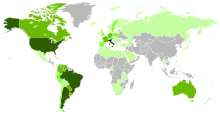 | |
| Total population | |
c. 140 million
| |
| Regions with significant populations | |
| Italy 55,551,000 | |
| Brazil | 25–34 million (incl. ancestry) |
| Argentina | 20–25 million (incl. ancestry) |
| United States | 16–23 million (incl. ancestry) |
| France | 5–6 million (incl. ancestry) |
| Paraguay | 2.5 million (incl. ancestry) |
| Colombia | 2 million (incl. ancestry) |
| Canada | 1.5 million (incl. ancestry) |
| Uruguay | 1.5 million (incl. ancestry) |
| Venezuela | 1–2 million (incl. ancestry) |
| Australia | 1.1 million (incl. ancestry) |
| Germany | 801,082 |
| Switzerland | 639,508 |
| Chile | 600,000 |
| Peru | 500,000 |
| Belgium | 451,825 |
| Costa Rica | 381,316 |
| Spain | 350,981 |
| United Kingdom | 280,000 |
| Mexico | 85,000 |
| South Africa | 77,400 |
| Ecuador | 56,000 |
| Russia | 53,649 |
| Netherlands | 52,789 |
| Austria | 38,904 |
| San Marino | 33,400 |
| Luxembourg | 30,933 |
| Portugal | 30,819 |
| Ireland | 22,160 |
| Croatia | 19,636 |
| Sweden | 19,087 |
| Albania | 19,000 |
| United Arab Emirates | 17,000 |
| Israel | 16,255 |
| Greece | 12,452 |
| Denmark | 10,092 |
| Poland | 10,000 |
| Thailand | 10,000 |
| Languages | |
| Italian and other languages of Italy | |
| Religion | |
| Predominantly Roman Catholicism Minority Irreligion | |
| Related ethnic groups | |
| Corsicans, Sammarinese, Sicilians, Sardinians, Maltese people | |
| Part of a series on |
| Italians |
|---|
 |
| List of Italians |
Italians (Template:Lang-it, Italian: [itaˈljaːni]) are a nation and ethnic group native to the Italian geographical region. Italians share a common core of culture, history, ancestry, and often the usage of Italian language or regional Italian languages.
The concept of Italia and the equivalent of "Italian" (such as Italic or Italiote) have existed since ancient times. The ancient peoples of Italy included the Etruscans, the Ligures, the Adriatic Veneti, the Sicani and Siculi (in Sicily), the Rhaetians, the Iapygians, the Nuragic peoples (in Sardinia), the Greek colonisers in Magna Graecia, the Phoenician settlers in the islands, the Rhaetians, the Cisalpine Gauls, the Latins. The Ancient Romans, made up of multiple ethnicities from within and outside of Italy, built a Mediterranean empire centred on Rome. In medieval times, parts of the peninsula have been occupied by foreign populations who were integrated in Italian culture, such as the Ostrogoths, Lombards, Franks, Normans, and Arabs. In the Modern Age, European powers such as the Spanish Empire, Kingdom of France and Austrian Empire controlled most of the peninsula. All these populations have left a strong regional influence on the culture, history, ancestry, and dialects of Italian language. Finally, emigration and immigration played a crucial role in developing local cultures, with both immigrant and returning emigrants introducing new costumes.
Today, Italian nationals are citizens of Italy, regardless of ancestry or nation of residence. However, Italian nationality (or citizenship) is largely based on jus sanguinis, according to which a person can claim Italian citizenship if they have ancestors with such citizenship. Still, Italian nationality is not necessarily synonymous with Italian ethnicity, as there are ethnic Italians without Italian citizenship or descendants of Italians in territories that were once part of an Italian state and now belong to another country (for instance in Nice, Istria, and Dalmatia); and ethnic Italians without citizenship who descend from emigrants of the Italian diaspora. In fact, is estimated that there are more people with the right to claim Italian nationality (~80 millions) than Italian nationals (~55 millions). It is also important to note that Italian nationality can be acquired by meeting other conditions, hinging on studying or working in Italy and passing an exam of language and culture.
The majority of Italian nationals are native speakers of the country's official language, Italian, a Romance language of the Indo-European language family that evolved from the Tuscanian dialects, themselves evolved from Vulgar Latin as most Italian dialects and minority languages. However, many Italians also speak a regional or minority language native to Italy, the existence of which predates the national language. It is important to note that Standard Italian was adopted in the whole peninsula only after the formation of the Kingdom of Italy in 1861, while regional dialects and minority languages have been the native tongue of most Italians, especially prior to the advent of mandatory education and mass media. For this reason and due to the history of political division and foreign presence in various areas of the peninsula, Italian culture and traditions differ across regions. Although there is disagreement on the total number, according to UNESCO, there are approximately 30 languages native to Italy, although many are often misleadingly referred to as "Italian dialects". The dialects and minority languages, together with foreign influences, affect the regional use of Italian.
Since 2017, in addition to the approximately 55 million Italians in Italy (91% of the Italian national population), Italian-speaking autonomous groups are found in neighboring nations; about a half million are in Switzerland, as well as in France, the entire population of San Marino. In addition, there are also clusters of Italian speakers in the former Yugoslavia, primarily in Istria, located between in modern Croatia and Slovenia (see: Istrian Italians), and Dalmatia, located in present-day Croatia and Montenegro (see: Dalmatian Italians). Due to the wide-ranging diaspora in the late 19th century and early 20th century, (with over 5 million Italian citizens that live outside of Italy) over 80 million people abroad claim full or partial Italian ancestry. This includes about 60% of Argentina's population (Italian Argentines), 44% of Uruguayans (Italian Uruguayans), 15% of Brazilians (Italian Brazilians, the largest Italian community outside Italy), more than 18 million Italian Americans, and people in other parts of Europe (e.g. Italians in Germany, Italians in France and Italians in the United Kingdom), the American Continent (such as Italian Venezuelans, Italian Canadians, Italian Colombians and Italians in Paraguay, among others), Australasia (Italian Australians and Italian New Zealanders), and to a lesser extent in the Middle East (Italians in the United Arab Emirates).
Italian people are generally known for their attachment to their family and local communities, expressed in the form of either regionalism or municipalism (in Italian, campanilismo, after the Italian word for bell tower (ita. campanile). Italians have influenced and contributed to fields such as arts and music, science, technology, fashion, cinema, cuisine, restaurants, sports, jurisprudence, banking and business.
Name
Main article: Name of Italy
Hypotheses for the etymology of Italia are numerous. One theory suggests it originated from an Ancient Greek term for the land of the Italói, a tribe that resided in the region now known as Calabria. Originally thought to be named Vituli, some scholars suggest their totemic animal to be the calf (Lat vitulus, Umbrian vitlo, Oscan Víteliú). Several ancient authors said it was named after a local ruler Italus.
The ancient Greek term for Italy initially referred only to the south of the Bruttium peninsula and parts of Catanzaro and Vibo Valentia. The larger concept of Oenotria and "Italy" became synonymous, and the name applied to most of Lucania as well. Before the Roman Republic's expansion, the name was used by Greeks for the land between the strait of Messina and the line connecting the gulfs of Salerno and Taranto, corresponding to Calabria. The Greeks came to apply "Italia" to a larger region. In addition to the "Greek Italy" in the south, historians have suggested the existence of an "Etruscan Italy", which consisted of areas of central Italy.
The borders of Roman Italy, Italia, are better established. Cato's Origines describes Italy as the entire peninsula south of the Alps. In 264 BC, Roman Italy extended from the Arno and Rubicon rivers of the centre-north to the entire south. The northern area, Cisalpine Gaul, considered geographically part of Italy, was occupied by Rome in the 220s BC, but remained politically separated. It was legally merged into the administrative unit of Italy in 42 BC. Sardinia, Corsica, Sicily, and Malta were added to Italy by Diocletian in 292 AD, which made late-ancient Italy coterminous with the modern Italian geographical region.
The Latin Italicus was used to describe "a man of Italy" as opposed to a provincial, or one from the Roman province. The adjective italianus, from which Italian was derived, is from Medieval Latin and was used alternatively with Italicus during the early modern period. After the fall of the Western Roman Empire, the Ostrogothic Kingdom of Italy was created. After the Lombard invasions, Italia was retained as the name for their kingdom, and its successor kingdom within the Holy Roman Empire.
History
Main article: Population history of Italy Further information: History of Italy, Ancient peoples of Italy, List of ancient Italic peoples, Roman people, Italic peoples, and Genetic history of Italy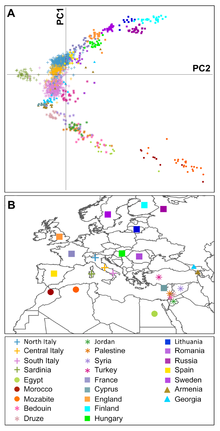
Due to historic demographic shifts in the Italian peninsula throughout history, its geographical position in the center of the Mediterranean Sea, as well as Italy's regional ethnic diversity since ancient times, modern Italians are genetically diverse. The Iron Age tribes of Italy are pre-Indo-European-speaking peoples, such as the Etruscans, Rhaetians, Camuni, Nuragics, Sicani, Elymians and the Ligures, and pre-Roman Indo-European-speaking peoples, such as the Celts (Gauls and Lepontii) mainly in northern Italy, and Iapygians, the Italic peoples throughout the peninsula (such as the Latino-Faliscans, the Osco-Umbrians, the Sicels and the Veneti), and a significant number of Greeks in southern Italy (the so-called "Magna Graecia"). Sicilians were also influenced by the Normans, specially during the Kingdom of Sicily.
Italians originate mostly from these primary elements and, like the rest of Romance-speaking Southern Europe, share a common Latin heritage and history. There are also elements such as the Bronze and Iron Age Middle Eastern admixture, characterized by high frequencies of Iranian and Anatolian Neolithic ancestries, including several other ancient signatures derived ultimately from the Caucasus, with a lower incidence in northern Italy compared to central and southern Italy. Ancient and medieval southern Mediterranean admixture is also found in mainland southern Italy and Sardinia. In their admixtures, Sicilians and southern Italians are closest to modern Greeks (as the historical region of Magna Graecia, "Greater Greece", bears witness to), while northern Italians are closest to the Spaniards and southern French.
Prehistory
Further information: Prehistoric Italy
Italians, like most Europeans, largely descend from three distinct lineages: Mesolithic hunter-gatherers, descended from populations associated with the Paleolithic Epigravettian culture; Neolithic Early European Farmers who migrated from Anatolia during the Neolithic Revolution 9,000 years ago; and Yamnaya Steppe pastoralists who expanded into Europe from the Pontic–Caspian steppe of Ukraine and southern Russia in the context of Indo-European migrations 5,000 years ago.
The earliest modern humans inhabiting Italy are believed to have been Paleolithic peoples that may have arrived in the Italian Peninsula as early as 35,000 to 40,000 years ago. Italy is believed to have been a major Ice Age refuge from which Paleolithic humans later colonized Europe.
The Neolithic colonization of Europe from Western Asia and the Middle East beginning around 10,000 years ago reached Italy, as most of the rest of the continent although, according to the demic diffusion model, its impact was most in the southern and eastern regions of the European continent.
Starting in the early Bronze Age, the first wave of migrations into Italy of Indo-European-speaking peoples occurred from Central Europe, with the appearance of the Bell Beaker culture. These were later (from the 14th century BC) followed by others that can be identified as Italo-Celts, with the appearance of the Celtic-speaking Canegrate culture and the Italic-speaking Proto-Villanovan culture, both deriving from the Proto-Italo-Celtic Urnfield culture. Recent DNA studies confirmed the arrival of Steppe-related ancestry in northern Italy to at least 2000 BCE and in Central Italy by 1600 BCE, with this ancestry component increasing through time.
In the Iron Age and late Bronze Age, Celtic-speaking La Tène and Hallstatt cultures spread over a large part of Italy, with related archeological artifacts found as far south as Apulia. Italics occupied northeastern, southern and central Italy: the "West Italic" group (including the Latins) were the first wave. They had cremation burials and possessed advanced metallurgical techniques. Major tribes included the Latins and Falisci in Lazio; the Oenotrians and Italii in Calabria; the Ausones, Aurunci and Opici in Campania; and perhaps the Veneti in Veneto and the Sicels in Sicily. They were followed, and largely displaced by the East Italic (Osco-Umbrians) group.
Pre-Roman

By the beginning of the Iron Age the Etruscans emerged as the dominant civilization on the Italian peninsula. The Etruscans, whose primary home was in Etruria, expanded over a large part of Italy, covering a territory, at its greatest extent, of roughly what is now Tuscany, western Umbria, and northern Lazio, as well as what are now the Po Valley, Emilia-Romagna, south-eastern Lombardy, southern Veneto, and western Campania. On the origins of the Etruscans, the ancient authors report several hypotheses, one of which claims that the Etruscans come from the Aegean Sea. Modern archaeological and genetic research concluded that the Etruscans were autochthonous and they had a genetic profile similar to their Latin neighbors. Both Etruscans and Latins joined firmly the European cluster lacking recent admixture with Anatolia or the Eastern Mediterranean.
The Ligures are said to have been one of the oldest populations in Italy and Western Europe, possibly of Pre-Indo-European origin. According to Strabo they were not Celts, but later became influenced by the Celtic culture of their neighbours, and thus are sometimes referred to as Celticized Ligurians or Celto-Ligurians. Their language had affinities with both Italic (Latin and the Osco-Umbrian languages) and Celtic (Gaulish). They primarily inhabited the regions of Liguria, Piedmont, northern Tuscany, western Lombardy, western Emilia-Romagna and northern Sardinia, but are believed to have once occupied an even larger portion of ancient Italy as far south as Sicily. They were also settled in Corsica and in the Provence region along the southern coast of modern France.
During the Iron Age, prior to Roman rule, the peoples living in the area of modern Italy and the islands were:
- Etruscans (Camunni, Lepontii, Raeti);
- Sicani;
- Elymians;
- Ligures (Apuani, Bagienni, Briniates, Corsi, Friniates, Garuli, Hercates, Ilvates, Insubres, Orobii, Laevi, Lapicini, Marici, Statielli, Taurini);
- Italics (Latins, Falisci, Marsi, Umbri, Volsci, Marrucini, Osci, Aurunci, Ausones, Campanians, Paeligni, Sabines, Bruttii, Frentani, Lucani, Samnites, Pentri, Caraceni, Caudini, Hirpini, Aequi, Fidenates, Hernici, Picentes, Vestini, Morgeti, Sicels, Veneti);
- Iapygians (Messapians, Daunians, Peucetians);
- Celts (Allobroges, Ausones, Boii, Carni, Cenomani, Ceutrones, Graioceli, Lepontii, Lingones, Segusini, Senones, Salassi, Veragri, Vertamocorii);
- Greeks of Magna Graecia;
- Sardinians (Nuragic tribes), in Sardinia;
Italy was, throughout the pre-Roman period, predominantly inhabited by Italic tribes who occupied the modern regions of Lazio, Umbria, Marche, Abruzzo, Molise, Campania, Basilicata, Calabria, Apulia and Sicily. Sicily, in addition to having an Italic population in the Sicels, also was inhabited by the Sicani and the Elymians, of uncertain origin. The Veneti, most often regarded as an Italic tribe, chiefly inhabited the Veneto, but extended as far east as Friuli-Venezia Giulia and Istria, and had colonies as far south as Lazio.
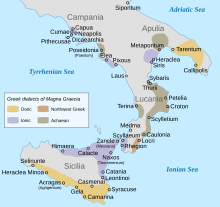
Northwest Doric Achaean Doric Doric proper Ionic
Beginning in the 8th century BC, Greeks arrived in Italy and founded cities along the coast of southern Italy and eastern Sicily, which became known as Magna Graecia ("Greater Greece"). The Greeks were frequently at war with the native Italic tribes, but nonetheless managed to Hellenize and assimilate a good portion of the indigenous population located along eastern Sicily and the southern coasts of the Italian mainland. According to Beloch the number of Greek citizens in south Italy at its greatest extent reached only 80,000–90,000, while the local people subjected by the Greeks were between 400,000 and 600,000. By the 4th and 3rd century BC, Greek power in Italy was challenged and began to decline, and many Greeks were pushed out of peninsular Italy by the native Oscan, Brutti and Lucani tribes.
The Gauls crossed the Alps and invaded northern Italy in the 4th and 3rd centuries BC, settling in the area that became known as Cisalpine Gaul ("Gaul on this side of the Alps"). Although named after the Gauls, the region was mostly inhabited by indigenous tribes, namely the Ligures, Etruscans, Veneti and Euganei. Estimates by Beloch and Brunt suggest that in the 3rd century BC the Gaulish settlers of north Italy numbered between 130,000 and 140,000 out of a total population of about 1.4 million. The northern half of Cisalpine Gaul was already inhabited by the Celtic Lepontii since the Bronze Age. Speaking about the Alpine region, the Greek historian Strabo, wrote:
The Alps are inhabited by numerous nations, but all Keltic with the exception of the Ligurians, and these, though of a different race, closely resemble them in their manner of life.
According to Pliny and Livy, after the invasion of the Gauls, some of the Etruscans living in the Po Valley sought refuge in the Alps and became known as the Raeti. The Raeti inhabited the region of Trentino-Alto Adige, as well as eastern Switzerland and Tyrol in western Austria. The Ladins of north-eastern Italy and the Romansh people of Switzerland are said to be descended from the Raeti.
Roman times through Middle Ages

The Romans—who according to legend originally consisted of three ancient tribes: Latins, Sabines and Etruscans—would go on to conquer the whole Italian peninsula. During the Roman period hundreds of cities and colonies were established throughout Italy, including Florence, Turin, Como, Pavia, Padua, Verona, Vicenza, Trieste and many others. Initially many of these cities were colonized by Latins, but later also included colonists belonging to the other Italic tribes who had become Latinized and joined to Rome. After the Roman conquest of Italy "the whole of Italy had become Latinized". After the Roman conquest of Cisalpine Gaul and the widespread confiscations of Gallic territory, some of the Gaulish population was either killed or expelled. Many colonies were established by the Romans in the former Gallic territory of Cisalpine Gaul, which was then settled by Roman and Italic people. These colonies included Bologna, Modena, Reggio Emilia, Parma, Piacenza, Cremona and Forlì. According to Strabo:
The Cispadane peoples occupy all that country which is encircled by the Apennine Mountains towards the Alps as far as Genua and Sabata. The greater part of the country used to be occupied by the Boii, Ligures, Senones, and Gaesatae; but since the Boii have been driven out, and since both the Gaesatae and the Senones have been annihilated, only the Ligurian tribes and the Roman colonies are left.
The Boii, the most powerful and numerous of the Gallic tribes, were expelled by the Romans after 191 BC and settled in Bohemia, while the Insubres still lived in Mediolanum in the 1st century BC.
Augustus created for the first time an administrative region called Italia with inhabitants called "Italicus populus", stretching from the Alps to Sicily: for this reason historians such as Emilio Gentile called him Father of Italians. Population movement and exchange among people from different regions was not uncommon during the Roman period. Latin colonies were founded at Ariminum in 268 and at Firmum in 264, while large numbers of Picentes, who previously inhabited the region, were moved to Paestum and settled along the river Silarus in Campania. Between 180 and 179 BC, 47,000 Ligures belonging to the Apuani tribe were removed from their home along the modern Ligurian-Tuscan border and deported to Samnium, an area corresponding to inland Campania, while Latin colonies were established in their place at Pisa, Lucca and Luni. Such population movements contributed to the rapid Romanization and Latinization of Italy.
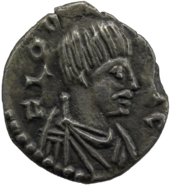
A large Germanic confederation of Sciri, Heruli, Turcilingi and Rugians, led by Odoacer, invaded and settled Italy in 476. They were preceded by Alemanni, including 30,000 warriors with their families, who settled in the Po Valley in 371, and by Burgundians who settled between northwestern Italy and southern France in 443. The Germanic tribe of the Ostrogoths led by Theoderic the Great conquered Italy and presented themselves as upholders of Latin culture, mixing Roman culture together with Gothic culture, in order to legitimize their rule amongst Roman subjects who had a long-held belief in the superiority of Roman culture over foreign "barbarian" Germanic culture. Since Italy had a population of several million, the Goths did not constitute a significant addition to the local population. At the height of their power, there were several thousand Ostrogoths in a population of 6 or 7 million. Before them, Radagaisus led tens of thousands of Goths in Italy in 406, though figures may be too high as ancient sources routinely inflated the numbers of tribal invaders. After the Gothic War, which devastated the local population, the Ostrogoths were defeated. Nevertheless, according to Roman historian Procopius of Caesarea, the Ostrogothic population was allowed to live peacefully in Italy with their Rugian allies under Roman sovereignty.
But in the sixth century, another Germanic tribe known as the Longobards invaded Italy, which in the meantime had been reconquered by the East Roman or Byzantine Empire. The Longobards were a small minority compared to the roughly four million people in Italy at the time. They were later followed by the Bavarians and the Franks, who conquered and ruled most of Italy. Some groups of Slavs settled in parts of the northern Italian peninsula between the 7th and the 8th centuries, while Bulgars led by Alcek settled in Sepino, Bojano and Isernia. These Bulgars preserved their speech and identity until the late 8th century.
Following Roman rule, Sicily, Corsica and Sardinia were conquered by the Vandals, then by the Ostrogoths, and finally by the Byzantines. At one point, Sardinia grew increasingly autonomous from the Byzantine rule to the point of organizing itself into four sovereign Kingdoms, known as "Judicates", that would last until the Aragonese conquest in the 15th century. Corsica came under the influence of the Kingdom of the Lombards and later under the maritime Republics of Pisa and Genoa. In 687, Sicily became the Byzantine Theme of Sicily; during the course of the Arab–Byzantine wars, Sicily gradually became the Emirate of Sicily (831–1072). Later, a series of conflicts with the Normans would bring about the establishment of the County of Sicily, and eventually the Kingdom of Sicily. An enormous Norman migration that lasted more than a century completely changed the Sicilian population with native peoples from Normandy, Great Britain and Scandinavia. The Lombards of Sicily (not to be confused with the Longobards), coming from northern Italy, settled in the central and eastern part of Sicily. After the marriage between the Norman Roger I of Sicily and Adelaide del Vasto, descendant of the Aleramici family, groups of people from northern Italy (known collectively as Lombards) left their homeland, in the Aleramici's possessions in Piedmont and Liguria (then known as Lombardy), to settle on the island of Sicily.
Before them, other Normans arrived in Sicily, with an expedition departed in 1038, led by the Byzantine commander George Maniakes, which for a very short time managed to snatch Messina and Syracuse from Arab rule. The Lombards who arrived with the Byzantines settled in Maniace, Randazzo and Troina, while a group of Genoese and other Lombards from Liguria settled in Caltagirone.
Renaissance to the modern era
Further information: Italian city-states and Italian language § Origins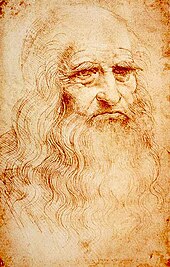

From the 11th century on, Italian cities began to grow rapidly in independence and importance. They became centres of political life, banking, and foreign trade. Some became wealthy, and many, including Florence, Rome, Genoa, Milan, Pisa, Siena and Venice, grew into nearly independent city-states and maritime republics. Each had its own foreign policy and political life. They all resisted, with varying degrees of success, the efforts of noblemen, emperors, and larger foreign powers to control them.
During the subsequent Swabian rule under the Holy Roman Emperor Frederick II, who spent most of his life as king of Sicily in his court in Palermo, Moors were progressively eradicated until the massive deportation of the last Muslims of Sicily. As a result of the Arab expulsion, many towns across Sicily were left depopulated. By the 12th century, Swabian kings granted immigrants from northern Italy (particularly Piedmont, Lombardy and Liguria), Latium and Tuscany in central Italy, and French regions of Normandy, Provence and Brittany. settlement into Sicily, re-establishing the Latin element into the island, a legacy which can be seen in the many Gallo-Italic dialects and towns found in the interior and western parts of Sicily, brought by these settlers. It is believed that the Lombard immigrants in Sicily over a couple of centuries were a total of about 200,000. An estimated 20,000 Swabians and 40,000 Normans settled in the southern half of Italy during this period. Additional Tuscan migrants settled in Sicily after the Florentine conquest of Pisa in 1406. The emergence of identifiable Italian dialects from Vulgar Latin, and as such the possibility of a specifically "Italian" ethnic identity, has no clear-cut date, but began in roughly the 12th century. Modern standard Italian derives from the written vernacular of Tuscan writers of the 12th century. The recognition of Italian vernaculars as literary languages in their own right began with De vulgari eloquentia, an essay written by Dante Alighieri at the beginning of the 14th century.
During the 14th and 15th centuries, some Italian city-states ranked among the most important powers of Europe. Venice, in particular, had become a major maritime power, and the city-states as a group acted as a conduit for goods from the Byzantine and Islamic empires. In this capacity, they provided great impetus to the developing Renaissance, began in Florence in the 14th century, and led to an unparalleled flourishing of the arts, literature, music, and science.
Substantial migrations of Lombards to Naples, Rome and Palermo, continued in the 16th and 17th centuries, driven by the constant overcrowding in the north. Beside that, minor but significant settlements of Slavs (the so-called Schiavoni) and Arbereshe in Italy have been recorded, while Scottish soldiers - the Garde Ecossaise - who served the French King, Francis I, settled in the mountains of Piedmont.
The geographical and cultural proximity with southern Italy pushed Albanians to cross the Strait of Otranto, especially after Skanderbeg's death and the conquest of the Balkans by the Ottomans. In defense of the Christian religion and in search of soldiers loyal to the Spanish crown, Alfonso V of Aragon, also king of Naples, invited Arbereshe soldiers to move to Italy with their families. In return the king guaranteed to Albanians lots of land and a favourable taxation.
Arbereshe and Schiavoni were used to repopulate abandoned villages or villages whose population had died in earthquakes, plagues and other catastrophes. Albanian soldiers were also used to quell rebellions in Calabria. Slavic colonies were established in eastern Friuli, Sicily and Molise (Molise Croats).
Between the Late Middle Ages and the early modern period, there were several waves of immigration of Albanians into Italy, in addition to another in the 20th century. The descendants of these Albanian emigrants, many still retaining the Albanian language, the Arbëresh dialect, have survived throughout southern Italy, numbering about 260,000 people, with roughly 80,000 to 100,000 speaking the Albanian language.
Culture
Main article: Culture of Italy
Italy is considered one of the birthplaces of Western civilization and a cultural superpower. Italian culture is the culture of the Italians and is incredibly diverse spanning the entirety of the Italian peninsula and the islands of Sardinia and Sicily. Italy has been the starting point of phenomena of international impact such as the Roman Republic, Roman Empire, the Roman Catholic Church, the Maritime republics, Romanesque art, Scholasticism, the Renaissance, the Age of Discovery, Mannerism, the Scientific revolution, the Baroque, Neoclassicism, the Risorgimento, Fascism, and European integration.
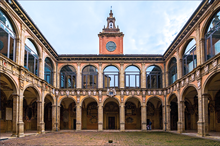
Italy also became a seat of great formal learning in 1088 with the establishment of the University of Bologna, the oldest university in continuous operation, and the first university in the sense of a higher-learning and degree-awarding institute, as the word universitas was coined at its foundation. Many other Italian universities soon followed. For example, the Schola Medica Salernitana, in southern Italy, was the first medical school in Europe. These great centres of learning presaged the Rinascimento: the European Renaissance began in Italy and was fueled throughout Europe by Italian painters, sculptors, architects, scientists, literature masters and music composers. Italy continued its leading cultural role through the Baroque period and into the Romantic period, when its dominance in painting and sculpture diminished but the Italians re-established a strong presence in music.
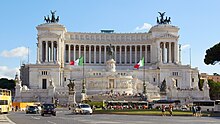
Due to comparatively late national unification, and the historical autonomy of the regions that comprise the Italian peninsula, many traditions and customs of the Italians can be identified by their regions of origin. Despite the political and social isolation of these regions, Italy's contributions to the cultural and historical heritage of the Western world remain immense. Famous elements of Italian culture are its opera and music, its iconic gastronomy and food, which are commonly regarded as amongst the most popular in the world, its cinema (with filmmakers such as Federico Fellini, Michelangelo Antonioni, Mario Monicelli, Sergio Leone, etc.), its collections of priceless works of art and its fashion (Milan and Florence are regarded as some of the few fashion capitals of the world).
Traditions of Italy are sets of traditions, beliefs, values, and customs that belongs within the culture of Italian people. These traditions have influenced life in Italy for centuries, and are still practiced in modern times. Italian traditions are directly connected to Italy's ancestors, which says even more about Italian history. Folklore of Italy refers to the folklore and urban legends of Italy. Within the Italian territory, various peoples have followed one another over time, each of which has left its mark on current culture. Some tales also come from Christianization, especially those concerning demons, which are sometimes recognized by Christian demonology. Italian folklore also includes Italian folk dance, Italian folk music and folk heroes.
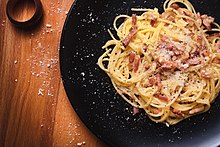
Italian cuisine is a Mediterranean cuisine consisting of the ingredients, recipes and cooking techniques developed across the Italian Peninsula since antiquity, and later spread around the world together with waves of Italian diaspora. Italian cuisine includes deeply rooted traditions common to the whole country, as well as all the regional gastronomies, different from each other, especially between the north, the centre and the south of Italy, which are in continuous exchange. Many dishes that were once regional have proliferated with variations throughout the country. The cuisine has influenced several other cuisines around the world, chiefly that of the United States in the form of Italian-American cuisine. The most popular dishes and recipes, over the centuries, have often been created by ordinary people more so than by chefs, which is why many Italian recipes are suitable for home and daily cooking, respecting regional specificities, privileging only raw materials and ingredients from the region of origin of the dish and preserving its seasonality.
Philosophy
Main article: Italian philosophy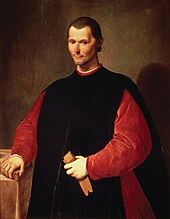
Over the ages, Italian literature had a vast influence on Western philosophy, beginning with the Greeks and Romans, and going onto Renaissance, The Enlightenment and modern philosophy. Italian medieval philosophy was mainly Christian, and included several important philosophers and theologians such as St Thomas Aquinas. Aquinas was the student of Albert the Great, a brilliant Dominican experimentalist, much like the Franciscan, Roger Bacon of Oxford in the 13th century. Aquinas reintroduced Aristotelian philosophy to Christianity. He believed that there was no contradiction between faith and secular reason. He believed that Aristotle had achieved the pinnacle in the human striving for truth and thus adopted Aristotle's philosophy as a framework in constructing his theological and philosophical outlook. He was a professor at the prestigious University of Paris.
Italy was also affected by the Enlightenment, a movement which was a consequence of the Renaissance and changed the road of Italian philosophy. Followers of the group often met to discuss in private salons and coffeehouses, notably in the cities of Milan, Rome and Venice. Cities with important universities such as Padua, Bologna and Naples, however, also remained great centres of scholarship and the intellect, with several philosophers such as Giambattista Vico (1668–1744) (who is widely regarded as being the founder of modern Italian philosophy) and Antonio Genovesi. Italian society also dramatically changed during the Enlightenment, with rulers such as Leopold II of Tuscany abolishing the death penalty. The church's power was significantly reduced, and it was a period of great thought and invention, with scientists such as Alessandro Volta and Luigi Galvani discovering new things and greatly contributing to Western science. Cesare Beccaria was also one of the greatest Italian Enlightenment writers and is now considered one of the fathers of classical criminal theory as well as modern penology. Beccaria is famous for his masterpiece On Crimes and Punishments (1764), a treatise (later translated into 22 languages) that served as one of the earliest prominent condemnations of torture and the death penalty and thus a landmark work in anti-death penalty philosophy.

Some of the most prominent philosophies and ideologies in Italy during the late 19th and 20th centuries include anarchism, communism, socialism, futurism, fascism, and Christian democracy. Antonio Rosmini, instead, was the founder of Italian idealism. Both futurism and fascism (in its original form, now often distinguished as Italian fascism) were developed in Italy at this time. From the 1920s to the 1940s, Italian Fascism was the official philosophy and ideology of the Italian government led by Benito Mussolini. Giovanni Gentile was one of the most significant 20th-century Idealist/Fascist philosophers. Meanwhile, anarchism, communism, and socialism, though not originating in Italy, took significant hold in Italy during the early 20th century, with the country producing numerous significant Italian anarchists, socialists, and communists. In addition, anarcho-communism first fully formed into its modern strain within the Italian section of the First International. Antonio Gramsci remains an important philosopher within Marxist and communist theory, credited with creating the theory of cultural hegemony.
Early Italian feminists include Sibilla Aleramo, Alaide Gualberta Beccari, and Anna Maria Mozzoni, though proto-feminist philosophies had previously been touched upon by earlier Italian writers such as Christine de Pizan, Moderata Fonte, and Lucrezia Marinella. Italian physician and educator Maria Montessori is credited with the creation of the philosophy of education that bears her name, an educational philosophy now practiced throughout the world. Giuseppe Peano was one of the founders of analytic philosophy and contemporary philosophy of mathematics. Recent analytic philosophers include Carlo Penco, Gloria Origgi, Pieranna Garavaso and Luciano Floridi.
Literature
Main article: Italian literature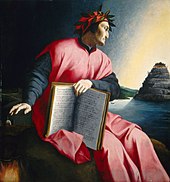
Formal Latin literature began in 240 BC, when the first stage play was performed in Rome. Latin literature was, and still is, highly influential in the world, with numerous writers, poets, philosophers, and historians, such as Pliny the Elder, Pliny the Younger, Virgil, Horace, Propertius, Ovid and Livy. The Romans were also famous for their oral tradition, poetry, drama and epigrams. In early years of the 13th century, St. Francis of Assisi was considered the first Italian poet by literary critics, with his religious song Canticle of the Sun.
Italian literature may be unearthed back to the Middle Ages, with the most significant poets of the period being Dante Alighieri, Petrarch, and Giovanni Boccaccio. During the Renaissance, humanists such as Leonardo Bruni, Coluccio Salutati and Niccolò Machiavelli were great collectors of antique manuscripts. Many worked for the organized Church and were in holy orders (like Petrarch), while others were lawyers and chancellors of Italian cities, like Petrarch's disciple, Salutati, the Chancellor of Florence, and thus had access to book copying workshops.

In the 18th century, the political condition of the Italian states began to improve, and philosophers disseminated their writings and ideas throughout Europe during the Age of Enlightenment. Apostolo Zeno and Metastasio are two of the notable figures of the age. Carlo Goldoni, a Venetian playwright and librettist, created the comedy of character. The leading figure of the 18th-century Italian literary revival was Giuseppe Parini.
One of the most remarkable poets of the early 19th and 20th century writers was Giacomo Leopardi, who is widely acknowledged to be one of the most radical and challenging thinkers of the 19th century. The main instigator of the reform was the Italian poet and novelist Alessandro Manzoni, notable for being the author of the historical novel I promessi sposi (The Betrothed, 1827–1842). Italo Svevo, the author of La coscienza di Zeno (1923), and Luigi Pirandello (winner of the 1934 Nobel Prize in Literature), who explored the shifting nature of reality in his prose fiction and such plays as Sei personaggi in cerca d'autore (Six Characters in Search of an Author, 1921). Federigo Tozzi and Giuseppe Ungaretti were well-known novelists, critically appreciated only in recent years, and regarded one of the forerunners of existentialism in the European novel.
Modern literary figures and Nobel laureates are Gabriele D'Annunzio from 1889 to 1910, nationalist poet Giosuè Carducci in 1906, realist writer Grazia Deledda in 1926, modern theatre author Luigi Pirandello in 1936, short stories writer Italo Calvino in 1960, poets Salvatore Quasimodo in 1959 and Eugenio Montale in 1975, Umberto Eco in 1980, and satirist and theatre author Dario Fo in 1997.
Theatre
Main article: Theatre of Italy
Italian theatre originates from the Middle Ages, with its background dating back to the times of the ancient Greek colonies of Magna Graecia, in southern Italy, the theatre of the Italic peoples and the theatre of ancient Rome. It can therefore be assumed that there were two main lines of which the ancient Italian theatre developed in the Middle Ages. The first, consisting of the dramatization of Catholic liturgies and of which more documentation is retained, and the second, formed by pagan forms of spectacle such as the staging for city festivals, the court preparations of the jesters and the songs of the troubadours. The Renaissance theatre marked the beginning of the modern theatre due to the rediscovery and study of the classics, the ancient theatrical texts were recovered and translated, which were soon staged at the court and in the curtensi halls, and then moved to real theatre. In this way the idea of theatre came close to that of today: a performance in a designated place in which the public participates. In the late 15th century two cities were important centers for the rediscovery and renewal of theatrical art: Ferrara and Rome. The first, vital center of art in the second half of the fifteenth century, saw the staging of some of the most famous Latin works by Plautus, rigorously translated into Italian.
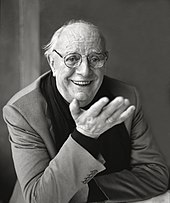
During the 16th century and on into the 18th century, commedia dell'arte was a form of improvisational theatre, and it is still performed today. Travelling troupes of players would set up an outdoor stage and provide amusement in the form of juggling, acrobatics and, more typically, humorous plays based on a repertoire of established characters with a rough storyline, called canovaccio. Plays did not originate from written drama but from scenarios called lazzi, which were loose frameworks that provided the situations, complications, and outcome of the action, around which the actors would improvise. The characters of the commedia usually represent fixed social types and stock characters, each of which has a distinct costume, such as foolish old men, devious servants, or military officers full of false bravado. The main categories of these characters include servants, old men, lovers, and captains.
The Ballet dance genre also originated in Italy. It began during the Italian Renaissance court as an outgrowth of court pageantry, where aristocratic weddings were lavish celebrations. Court musicians and dancers collaborated to provide elaborate entertainment for them. At first, ballets were woven in to the midst of an opera to allow the audience a moment of relief from the dramatic intensity. By the mid-seventeenth century, Italian ballets in their entirety were performed in between the acts of an opera. Over time, Italian ballets became part of theatrical life: ballet companies in Italy's major opera houses employed an average of four to twelve dancers; in 1815 many companies employed anywhere from eighty to one hundred dancers.
Noteworthy Italian theater actors and playwrights are Jacopone da Todi, Angelo Beolco, Isabella Andreini, Carlo Goldoni, Eduardo Scarpetta, Ettore Petrolini, Eleonora Duse, Eduardo De Filippo, Carmelo Bene and Giorgio Strehler.
Cuisine
Main article: Italian cuisine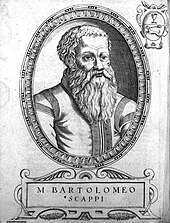
Italian cuisine is a Mediterranean cuisine consisting of the ingredients, recipes and cooking techniques developed in Italy since Roman times, and later spread around the world together with waves of Italian diaspora. Italian cuisine includes deeply rooted traditions common to the whole country, as well as all the regional gastronomies, different from each other, especially between the north, the centre and the south of Italy, which are in continuous exchange. Many dishes that were once regional have proliferated with variations throughout the country. Italian cuisine offers an abundance of taste, and has influenced several other cuisines around the world, chiefly that of the United States. Italian cuisine has developed through centuries of social and political changes, it has its roots in ancient Rome.
One of the main characteristics of Italian cuisine is its simplicity, with many dishes made up of few ingredients, and therefore Italian cooks often rely on the quality of the ingredients, rather than the complexity of preparation. The most popular dishes and recipes, over the centuries, have often been created by ordinary people more so than by chefs, which is why many Italian recipes are suitable for home and daily cooking, respecting regional specificities, privileging only raw materials and ingredients from the region of origin of the dish and preserving its seasonality.
Noteworthy Italian chefs are Bartolomeo Scappi, Gualtiero Marchesi, Lidia Bastianich, Antonio Carluccio, Cesare Casella, Carlo Cracco, Antonino Cannavacciuolo, Gino D'Acampo, Gianfranco Chiarini, Massimiliano Alajmo, Massimo Bottura and Bruno Barbieri.
Visual art
Main article: Italian art
The history of Italian visual arts is significant to the history of Western painting. Roman art was influenced by Greece and can in part be taken as a descendant of ancient Greek painting. Roman painting does have its own unique characteristics. The only surviving Roman paintings are wall paintings, many from villas in Campania, in southern Italy. Such paintings can be grouped into four main "styles" or periods and may contain the first examples of trompe-l'œil, pseudo-perspective, and pure landscape.
Panel painting becomes more common during the Romanesque period, under the heavy influence of Byzantine icons. Towards the middle of the 13th century, medieval art and Gothic painting became more realistic, with the beginnings of interest in the depiction of volume and perspective in Italy with Cimabue and then his pupil Giotto. From Giotto onwards, the treatment of composition in painting became much more free and innovative.

The Italian Renaissance is said by many to be the golden age of painting; roughly spanning the 14th through the mid-17th centuries with a significant influence also out of the borders of modern Italy. In Italy artists such as Paolo Uccello, Fra Angelico, Masaccio, Piero della Francesca, Andrea Mantegna, Filippo Lippi, Giorgione, Tintoretto, Sandro Botticelli, Leonardo da Vinci, Michelangelo, Raphael, Giovanni Bellini, and Titian took painting to a higher level through the use of perspective, the study of human anatomy and proportion, and through their development of refined drawing and painting techniques. Michelangelo was active as a sculptor from about 1500 to 1520; works include his David, Pietà, Moses. Other Renaissance sculptors include Lorenzo Ghiberti, Luca Della Robbia, Donatello, Filippo Brunelleschi and Andrea del Verrocchio.

In the 15th and 16th centuries, the High Renaissance gave rise to a stylised art known as Mannerism. In place of the balanced compositions and rational approach to perspective that characterised art at the dawn of the 16th century, the Mannerists sought instability, artifice, and doubt. The unperturbed faces and gestures of Piero della Francesca and the calm Virgins of Raphael are replaced by the troubled expressions of Pontormo and the emotional intensity of El Greco.
In the 17th century, among the greatest painters of Italian Baroque are Caravaggio, Annibale Carracci, Artemisia Gentileschi, Mattia Preti, Carlo Saraceni and Bartolomeo Manfredi. Subsequently, in the 18th century, Italian Rococo was mainly inspired by French Rococo, since France was the founding nation of that particular style, with artists such as Giovanni Battista Tiepolo and Canaletto. Italian Neoclassical sculpture focused, with Antonio Canova's nudes, on the idealist aspect of the movement.
In the 19th century, major Italian Romantic painters were Francesco Hayez, Giuseppe Bezzuoli and Francesco Podesti. Impressionism was brought from France to Italy by the Macchiaioli, led by Giovanni Fattori, and Giovanni Boldini; Realism by Gioacchino Toma and Giuseppe Pellizza da Volpedo. In the 20th century, with Futurism, primarily through the works of Umberto Boccioni and Giacomo Balla, Italy rose again as a seminal country for artistic evolution in painting and sculpture. Futurism was succeeded by the metaphysical paintings of Giorgio de Chirico, who exerted a strong influence on the Surrealists and generations of artists to follow such as Bruno Caruso and Renato Guttuso.
Architecture
Main article: Architecture of Italy See also: List of World Heritage Sites in Italy
Italians are known for their significant architectural achievements, such as the construction of arches, domes and similar structures during ancient Rome, the founding of the Renaissance architectural movement in the late-14th to 16th centuries, and being the homeland of Palladianism, a style of construction which inspired movements such as that of Neoclassical architecture, and influenced the designs which noblemen built their country houses all over the world, notably in the UK, Australia and the US during the late 17th to early 20th centuries. Several of the finest works in Western architecture, such as the Colosseum, the Milan Cathedral and Florence cathedral, the Leaning Tower of Pisa and the building designs of Venice are found in Italy.
Italian architecture has also widely influenced the architecture of the world. British architect Inigo Jones, inspired by the designs of Italian buildings and cities, brought back the ideas of Italian Renaissance architecture to 17th-century England, being inspired by Andrea Palladio. Additionally, Italianate architecture, popular abroad since the 19th century, was used to describe foreign architecture which was built in an Italian style, especially modelled on Renaissance architecture.
Italian modern and contemporary architecture refers to architecture in Italy during 20th and 21st centuries. During the Fascist period the so-called "Novecento movement" flourished, with figures such as Gio Ponti, Peter Aschieri, Giovanni Muzio. This movement was based on the rediscovery of imperial Rome. Marcello Piacentini, who was responsible for the urban transformations of several cities in Italy, and remembered for the disputed Via della Conciliazione in Rome, devised a form of "simplified Neoclassicism".
The fascist architecture (shown perfectly in the EUR buildings) was followed by the Neoliberty style (seen in earlier works of Vittorio Gregotti) and Brutalist architecture (Torre Velasca in Milan group BBPR, a residential building via Piagentina in Florence, Leonardo Savioli and works by Giancarlo De Carlo).
Music
Main article: Music of Italy
From folk music to classical, music has always played an important role in Italian culture. Instruments associated with classical music, including the piano and violin, were invented in Italy, and many of the prevailing classical music forms, such as the symphony, concerto, and sonata, can trace their roots back to innovations of 16th- and 17th-century Italian music. Italians invented many of the musical instruments, including the piano and violin.
Most notable Italians composers include the Giovanni Pierluigi da Palestrina, Claudio Monteverdi, the Baroque composers Scarlatti, Corelli and Vivaldi, the Classical composers Paganini and Rossini, and the Romantic composers Verdi and Puccini, whose operas, including La bohème, Tosca, Madama Butterfly, and Turandot, are among the most frequently worldwide performed in the standard repertoire. Modern Italian composers such as Berio and Nono proved significant in the development of experimental and electronic music. While the classical music tradition still holds strong in Italy, as evidenced by the fame of its innumerable opera houses, such as La Scala of Milan and San Carlo of Naples, and performers such as the pianist Maurizio Pollini and the late tenor Luciano Pavarotti, Italians have been no less appreciative of their thriving contemporary music scene.

Italians are amply known as the mothers of opera. Italian opera was believed to have been founded in the early 17th century, in Italian cities such as Mantua and Venice. Later, works and pieces composed by native Italian composers of the 19th and early 20th centuries, such as Rossini, Bellini, Donizetti, Verdi and Puccini, are among the most famous operas ever written and today are performed in opera houses across the world. La Scala operahouse in Milan is also renowned as one of the best in the world. Famous Italian opera singers include Enrico Caruso and Alessandro Bonci.

Introduced in the early 1920s, jazz took a particularly strong foothold among Italians, and remained popular despite the xenophobic cultural policies of the Fascist regime. Today, the most notable centres of jazz music in Italy include Milan, Rome, and Sicily. Later, Italy was at the forefront of the progressive rock movement of the 1970s, with bands such as PFM and Goblin. Italy was also an important country in the development of disco and electronic music, with Italo disco, known for its futuristic sound and prominent usage of synthesizers and drum machines, being one of the earliest electronic dance genres, as well as European forms of disco aside from Euro disco (which later went on to influence several genres such as Eurodance and Nu-disco).
Producers and songwriters such as Giorgio Moroder, who won three Academy Awards for his music, were highly influential in the development of EDM (electronic dance music). Today, Italian pop music is represented annually with the Sanremo Music Festival, which served as inspiration for the Eurovision song contest, and the Festival of Two Worlds in Spoleto. Singers such as pop diva Mina, classical crossover artist Andrea Bocelli, Grammy winner Laura Pausini, and European chart-topper Eros Ramazzotti have attained international acclaim.
Cinema
Main articles: Cinema of Italy, List of Italian film directors, and List of Italian actors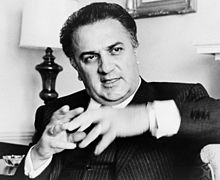
Since the development of the Italian film industry in the early 1900s, Italian filmmakers and performers have, at times, experienced both domestic and international success, and have influenced film movements throughout the world. The history of Italian cinema began a few months after the Lumière brothers began motion picture exhibitions. The first Italian director is considered to be Vittorio Calcina, a collaborator of the Lumière Brothers, who filmed Pope Leo XIII in 1896. In the 1910s the Italian film industry developed rapidly. Cabiria, a 1914 Italian epic film directed by Giovanni Pastrone, is considered the most famous Italian silent film. It was also the first film in history to be shown in the White House. The oldest European avant-garde cinema movement, Italian futurism, took place in the late 1910s.
After a period of decline in the 1920s, the Italian film industry was revitalized in the 1930s with the arrival of sound film. A popular Italian genre during this period, the Telefoni Bianchi, consisted of comedies with glamorous backgrounds. Calligrafismo was instead in a sharp contrast to Telefoni Bianchi-American style comedies and is rather artistic, highly formalistic, expressive in complexity and deals mainly with contemporary literary material.
 Vittorio De Sica, one of the world's most acclaimed and influential filmmakers of all time
Vittorio De Sica, one of the world's most acclaimed and influential filmmakers of all time Sergio Leone, widely regarded as one of the most influential directors in the history of cinema
Sergio Leone, widely regarded as one of the most influential directors in the history of cinema
A new era took place at the end of World War II, with the Italian film that was widely recognised and exported until an artistic decline around the 1980s. Notable Italian film directors from this period include Vittorio De Sica, Federico Fellini, Sergio Leone, Pier Paolo Pasolini, Luchino Visconti, Michelangelo Antonioni, Dussio Tessari and Roberto Rossellini; some of these are recognised among the greatest and most influential filmmakers of all time. Movies include world cinema treasures such as Bicycle Thieves, La dolce vita, 8½, The Good, the Bad and the Ugly, and Once Upon a Time in the West. The mid-1940s to the early 1950s was the heyday of neorealist films, reflecting the poor condition of post-war Italy. Actresses such as Sophia Loren, Giulietta Masina and Gina Lollobrigida achieved international stardom during this period.
Since the early 1960s they also popularized a large number of genres and subgenres, such as peplum, Macaroni Combat, musicarello, poliziotteschi and commedia sexy all'italiana. The spaghetti Western achieved popularity in the mid-1960s, peaking with Sergio Leone's Dollars Trilogy, which featured enigmatic scores by composer Ennio Morricone. Erotic Italian thrillers, or gialli, produced by directors such as Mario Bava and Dario Argento in the 1970s, influenced the horror genre worldwide. In recent years, directors such as Ermanno Olmi, Bernardo Bertolucci, Giuseppe Tornatore, Gabriele Salvatores, Roberto Benigni, Matteo Garrone, Paolo Sorrentino and Luca Guadagnino brought critical acclaim back to Italian cinema.
The Venice International Film Festival, awarding the "Golden Lion" and held annually since 1932, is the oldest film festival in the world and one of the "Big Three" alongside Cannes and Berlin. The country is also famed for its prestigious David di Donatello. Italy is the most awarded country at the Academy Awards for Best Foreign Language Film, with 14 awards won, 3 Special Awards and 28 nominations. As of 2016, Italian films have also won 12 Palmes d'Or (the second-most of any country), 11 Golden Lions and 7 Golden Bears. The list of the 100 Italian films to be saved was created with the aim to report "100 films that have changed the collective memory of the country between 1942 and 1978".
Fashion and design
Main articles: Italian fashion, Italian design, and History of Italian fashion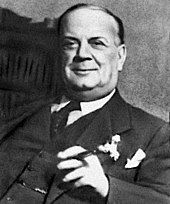
Italian fashion has a long tradition. Milan, Florence and Rome are Italy's main fashion capitals. According to Top Global Fashion Capital Rankings 2013 by Global Language Monitor, Rome ranked sixth worldwide when Milan was twelfth. Previously, in 2009, Milan was declared as the "fashion capital of the world" by Global Language Monitor itself. Currently, Milan and Rome, annually compete with other major international centres, such as Paris, New York, London, and Tokyo.
The Italian fashion industry is one of the country's most important manufacturing sectors. The majority of the older Italian couturiers are based in Rome. However, Milan is seen as the fashion capital of Italy because many well-known designers are based there and it is the venue for the Italian designer collections. Major Italian fashion labels, such as Gucci, Armani, Prada, Versace, Valentino, Dolce & Gabbana, Missoni, Fendi, Moschino, Max Mara, Trussardi, Benetton, and Ferragamo, to name a few, are regarded as among the finest fashion houses in the world.
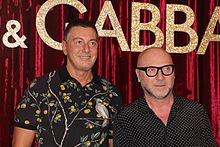
Accessory and jewelry labels, such as Bulgari, Luxottica, Buccellati have been founded in Italy and are internationally acclaimed, and Luxottica is the world's largest eyewear company. Also, the fashion magazine Vogue Italia, is considered one of the most prestigious fashion magazines in the world. The talent of young, creative fashion is also promoted, as in the ITS young fashion designer competition in Trieste.
Italy is also prominent in the field of design, notably interior design, architectural design, industrial design, and urban design. The country has produced some well-known furniture designers, such as Gio Ponti and Ettore Sottsass, and Italian phrases such as Bel Disegno and Linea Italiana have entered the vocabulary of furniture design. Examples of classic pieces of Italian white goods and pieces of furniture include Zanussi's washing machines and fridges, the "New Tone" sofas by Atrium, and the post-modern bookcase by Ettore Sottsass, inspired by Bob Dylan's song "Stuck Inside of Mobile with the Memphis Blues Again".
Italy is recognized as being a worldwide trendsetter and leader in design. Italy today still exerts a vast influence on urban design, industrial design, interior design, and fashion design worldwide. Today, Milan and Turin are the nation's leaders in architectural design and industrial design. The city of Milan hosts the FieraMilano, Europe's biggest design fair. Milan also hosts major design and architecture-related events and venues, such as the Fuori Salone and the Salone del Mobile, and has been home to the designers Bruno Munari, Lucio Fontana, Enrico Castellani, and Piero Manzoni.
Notable Italian fashion designers are Guccio Gucci, Salvatore Ferragamo, Giorgio Armani, Gianni Versace, Valentino, Ottavio Missoni, Nicola Trussardi, Mariuccia Mandelli, Rocco Barocco, Roberto Cavalli, Renato Balestra, Laura Biagiotti, Stefano Gabbana and Domenico Dolce.
Nobel Prizes
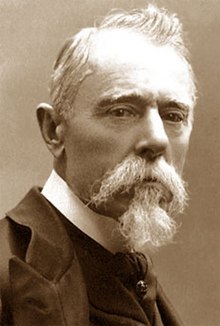

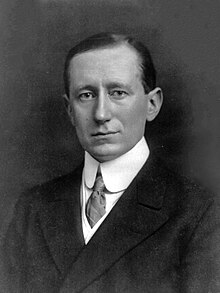

| Year | Winner | Branch | Contribution |
|---|---|---|---|
| 1906 | Giosuè Carducci | Literature | "Not only in consideration of his deep learning and critical research, but above all as a tribute to the creative energy, freshness of style, and lyrical force which characterize his poetic masterpieces". |
| 1906 | Camillo Golgi | Medicine | "In recognition of his work on the structure of the nervous system". |
| 1907 | Ernesto Teodoro Moneta | Peace | "For his work in the press and in peace meetings, both public and private, for an understanding between France and Italy". |
| 1909 | Guglielmo Marconi | Physics | "In recognition of his contributions to the development of wireless telegraphy". |
| 1926 | Grazia Deledda | Literature | "For her idealistically inspired writings which with plastic clarity picture the life on her native island and with depth and sympathy deal with human problems in general." |
| 1934 | Luigi Pirandello | Literature | "For his bold and ingenious revival of dramatic and scenic art." |
| 1938 | Enrico Fermi | Physics | "For his demonstrations of the existence of new radioactive elements produced by neutron irradiation, and for his related discovery of nuclear reactions brought about by slow neutrons." |
| 1957 | Daniel Bovet | Medicine | "For his discoveries relating to synthetic compounds that inhibit the action of certain body substances, and especially their action on the vascular system and the skeletal muscles." |
| 1959 | Salvatore Quasimodo | Literature | "For his lyrical poetry, which with classical fire expresses the tragic experience of life in our own times." |
| 1959 | Emilio Gino Segrè | Physics | "For his discovery of the anti-proton." |
| 1963 | Giulio Natta | Chemistry | "For his discoveries in the field of the chemistry and technology of high polymers." |
| 1969 | Salvatore Luria | Medicine | "For his discoveries concerning the replication mechanism and the genetic structure of viruses." |
| 1975 | Renato Dulbecco | Medicine | "For his discoveries concerning the interaction between tumour viruses and the genetic material of the cell." |
| 1975 | Eugenio Montale | Literature | "For his distinctive poetry which, with great artistic sensitivity, has interpreted human values under the sign of an outlook on life with no illusions." |
| 1984 | Carlo Rubbia | Physics | "For his decisive contributions to the large project, which led to the discovery of the field particles W and Z, communicators of weak interaction." |
| 1985 | Franco Modigliani | Economics | "For his pioneering analyses of saving and of financial markets"." |
| 1986 | Rita Levi-Montalcini | Medicine | "For her discoveries in growth factors." |
| 1997 | Dario Fo | Literature | "Who emulates the jesters of the Middle Ages in scourging authority and upholding the dignity of the downtrodden." |
| 2002 | Riccardo Giacconi | Physics | "For pioneering contributions to astrophysics, which have led to the discovery of cosmic X-ray sources." |
| 2007 | Mario Capecchi | Medicine | "For his discoveries of principles for introducing specific gene modifications in mice by the use of embryonic stem cells." |
| 2021 | Giorgio Parisi | Physics | "For the discovery of the interplay of disorder and fluctuations in physical systems from atomic to planetary scales." |
Italian surnames
| Part of a series on the |
| Culture of Italy |
|---|
 |
| History |
| People |
| Languages |
| Traditions |
| Mythology and folklore |
| Cuisine |
Festivals
|
| Religion |
| Art |
| Literature |
| Music and performing arts |
| Media |
| SportCalcio storico Football in Italy |
| Monuments |
| Symbols |
| Organisations |
Most of Italy's surnames (cognomi), with the exception of a few areas marked by linguistic minorities, derive from Italian and arose from an individual's peculiar (physical, etc.) qualities (e.g. Rossi, Bianchi, Quattrocchi, Mancini, Grasso, etc.), occupation (Ferrari, Auditore, Sartori, Tagliabue, etc.), relation of fatherhood or lack thereof (De Pretis, Orfanelli, Esposito, Trovato, etc.), and geographic location (Padovano, Pisano, Leccese, Lucchese, etc.). Some of them also indicate a remote foreign origin (Greco, Tedesco, Moro, Albanese, etc.).
| Most common surnames | |
|---|---|
| 1 | Rossi |
| 2 | Ferrari |
| 3 | Russo |
| 4 | Bianchi |
| 5 | Romano |
| 6 | Gallo |
| 7 | Costa |
| 8 | Fontana |
| 9 | Conti |
| 10 | Esposito |
| 11 | Ricci |
| 12 | Bruno |
| 13 | Rizzo |
| 14 | Moretti |
| 15 | De Luca |
| 16 | Marino |
| 17 | Greco |
| 18 | Barbieri |
| 19 | Lombardi |
| 20 | Giordano |
Italian diaspora
Main articles: Italian diaspora and Oriundo
Italian migration outside Italy took place, in different migrating cycles, for centuries. A diaspora in high numbers took place after Italy's unification in 1861 and continued through 1914 with the beginning of the First World War. This rapid outflow and migration of Italian people across the globe can be attributed to factors such as the internal economic slump that emerged alongside Italy's unification, family, and the industrial boom that occurred in the world surrounding Italy.
Italy after its unification did not seek nationalism but sought work instead. However, a unified state did not automatically constitute a sound economy. The global economic expansion, ranging from Britain's Industrial Revolution in the late 18th and through mid 19th century, to the use of slave labor in the Americas did not hit Italy until much later (with the exception of the "industrial triangle" between Milan, Genoa and Turin) This lag resulted in a deficit of work available in Italy and the need to look for work elsewhere. The mass industrialization and urbanization globally resulted in higher labor mobility and the need for Italians to stay anchored to the land for economic support declined.
Moreover, better opportunities for work were not the only incentive to move; family played a major role and the dispersion of Italians globally. Italians were more probably to migrate to countries where they had family established beforehand. These ties are shown to be stronger in many cases than the monetary incentive for migration, taking into account a familial base and possibly an Italian migrant community, greater connections to find opportunities for work, housing etc. Thus, thousands of Italian men and women left Italy and dispersed around the world and this trend only increased as the First World War approached.
Notably, it was not as if Italians had never migrated before; internal migration between north and southern Italy before unification was common. northern Italy caught on to industrialization sooner than southern Italy, therefore it was considered more modern technologically, and tended to be inhabited by the bourgeoisie. Alternatively, rural and agro-intensive southern Italy was seen as economically backward and was mainly populated by lower class peasantry. Given these disparities, prior to unification (and arguably after) the two sections of Italy, north and south were essentially seen by Italians and other nations as separate countries. So, migrating from one part of Italy to next could be seen as though they were indeed migrating to another country or even continent.
Furthermore, large-scale migrations phenomena did not recede until the late 1920s, well into the Fascist regime, and a subsequent wave can be observed after the end of the Second World War. Another wave is currently happening due to the ongoing debt crisis.
Over 80 million people of full or part Italian descent live outside Europe, with about 50 million living in South America (mostly in Brazil, which has the largest number of Italian descendants outside Italy, and Argentina, where over 62.5% of the population have at least one Italian ancestor), about 23 million living in North America (United States and Canada) and 1 million in Oceania (Australia and New Zealand). Others live in other parts of Europe (primarily the United Kingdom, Germany, France and Switzerland).

A historical Italian community has also existed in Gibraltar since the 16th century. To a lesser extent, people of full or partial Italian descent are also found in Africa (most notably in the former Italian colonies of Eritrea, which has 100,000 descendants, Somalia, Libya, Ethiopia, and in others countries such as South Africa, with 77,400 descendants, Tunisia and Egypt), in the Middle East (in recent years the United Arab Emirates has maintained a desirable destination for Italian immigrants, with currently 10,000 Italian immigrants), and Asia (Singapore is home to a sizeable Italian community).
Regarding the diaspora, there are many individuals of Italian descent who are possibly eligible for Italian citizenship by method of jus sanguinis, which is from the Latin meaning "by blood". However, just having Italian ancestry is not enough to qualify for Italian citizenship. To qualify, one must have at least one Italian-born citizen ancestor who, after emigrating from Italy to another country, had passed citizenship onto their children before they naturalized as citizens of their newly adopted country. The Italian government does not have a rule regarding on how many generations born outside of Italy can claim Italian nationality.
Geographic distribution of Italian speakers
Main article: Geographical distribution of Italian speakers See also: Italian language, Regional Italian, and Languages of Italy
The majority of Italian nationals are native speakers of the country's official language, Italian, or a variety thereof, that is regional Italian. However, many of them also speak a regional or minority language native to Italy, the existence of which predates the national language. Although there is disagreement on the total number, according to UNESCO, there are approximately 30 languages native to Italy, although many are often misleadingly referred to as "Italian dialects".
Italian is an official language of Italy and San Marino and is spoken fluently by the majority of the countries' populations. Italian is the third most spoken language in Switzerland (after German and French; see Swiss Italian), though its use there has moderately declined since the 1970s. It is official both on the national level and on regional level in two cantons: Ticino and Grisons. In the latter canton, however, it is only spoken by a small minority, in the Italian Grisons. Ticino, which includes Lugano, the largest Italian-speaking city outside Italy, is the only canton where Italian is predominant. Italian is also used in administration and official documents in Vatican City.
Italian is also spoken by a minority in Monaco and France, especially in the southeastern part of the country. Italian was the official language in Savoy and in Nice until 1860, when they were both annexed by France under the Treaty of Turin, a development that triggered the "Niçard exodus", or the emigration of a quarter of the Niçard Italians to Italy, and the Niçard Vespers. Italian was the official language of Corsica until 1859. Italian is generally understood in Corsica by the population resident therein who speak Corsican, which is an Italo-Romance idiom similar to Tuscan. Italian was the official language in Monaco until 1860, when it was replaced by the French. This was due to the annexation of the surrounding County of Nice to France following the Treaty of Turin (1860).

It formerly had official status in Montenegro (because of the Venetian Albania), parts of Slovenia and Croatia (because of the Venetian Istria and Venetian Dalmatia), parts of Greece (because of the Venetian rule in the Ionian Islands and by the Kingdom of Italy in the Dodecanese). Italian is widely spoken in Malta, where nearly two-thirds of the population can speak it fluently (see Maltese Italian). Italian served as Malta's official language until 1934, when it was abolished by the British colonial administration amid strong local opposition. Italian language in Slovenia is an officially recognized minority language in the country. The official census, carried out in 2002, reported 2,258 ethnic Italians (Istrian Italians) in Slovenia (0.11% of the total population). Italian language in Croatia is an official minority language in the country, with many schools and public announcements published in both languages. The 2001 census in Croatia reported 19,636 ethnic Italians (Istrian Italians and Dalmatian Italians) in the country (some 0.42% of the total population). Their numbers dropped dramatically after World War II following the Istrian–Dalmatian exodus, which caused the emigration of between 230,000 and 350,000 Istrian Italians and Dalmatian Italians. Italian was the official language of the Republic of Ragusa from 1492 to 1807.
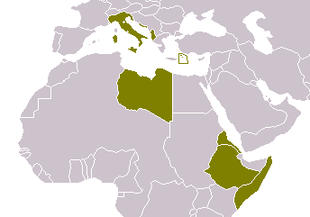
It formerly had official status in Albania due to the annexation of the country to the Kingdom of Italy (1939–1943). Albania has a large population of non-native speakers, with over half of the population having some knowledge of the Italian language. The Albanian government has pushed to make Italian a compulsory second language in schools. The Italian language is well-known and studied in Albania, due to its historical ties and geographical proximity to Italy and to the diffusion of Italian television in the country.
Due to heavy Italian influence during the Italian colonial period, Italian is still understood by some in former colonies. Although it was the primary language in Libya since colonial rule, Italian greatly declined under the rule of Muammar Gaddafi, who expelled the Italian Libyan population and made Arabic the sole official language of the country. A few hundred Italian settlers returned to Libya in the 2000s.
The legacy of the Italians in Tunisia is extensive. It goes from the construction of roads and buildings to literature and gastronomy (many Tunisian dishes are heavily influenced by the Sicilian gastronomy). Even the Tunisian language has many words borrowed from the Italian language. For example, "fatchatta" from Italian "facciata" (facade), "trino" from Italian "treno" (train), "miziria" from Italian "miseria" (misery), "jilat" from Italian "gelato" (ice cream), "guirra" from Italian "guerra" (war), etc.
Italian was the official language of Eritrea during Italian colonisation. Italian is today used in commerce, and it is still spoken especially among elders; besides that, Italian words are incorporated as loan words in the main language spoken in the country (Tigrinya). The capital city of Eritrea, Asmara, still has several Italian schools, established during the colonial period. In the early 19th century, Eritrea was the country with the highest number of Italians abroad, and the Italian Eritreans grew from 4,000 during World War I to nearly 100,000 at the beginning of World War II. In Asmara there are two Italian schools, the Italian School of Asmara (Italian primary school with a Montessori department) and the Liceo Sperimentale "G. Marconi" (Italian international senior high school).
Italian was also introduced to Somalia through colonialism and was the sole official language of administration and education during the colonial period but fell out of use after government, educational and economic infrastructure were destroyed in the Somali Civil War.
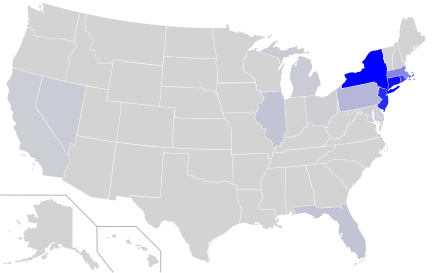
Italian is also spoken by large immigrant and expatriate communities in the Americas and Australia. Although over 17 million Americans are of Italian descent, only a little over one million people in the United States speak Italian at home. Nevertheless, an Italian language media market does exist in the country. In Canada, Italian is the second most spoken non-official language when varieties of Chinese are not grouped together, with 375,645 claiming Italian as their mother tongue in 2016.
Italian immigrants to South America have also brought a presence of the language to that continent. According to some sources, Italian is the second most spoken language in Argentina after the official language of Spanish, although its number of speakers, mainly of the older generation, is decreasing. Italian bilingual speakers can be found in the southeast of Brazil as well as in the south, corresponding to 2.07% of the total population of the country. In Venezuela, Italian is the most spoken language after Spanish and Portuguese, with around 200,000 speakers. In Uruguay, people who speak Italian as their home language are 1.1% of the total population of the country. In Australia, Italian is the second most spoken foreign language after Chinese, with 1.4% of the population speaking it as their home language.
The main Italian-language newspapers published outside Italy are the L'Osservatore Romano (Vatican City), the L'Informazione di San Marino (San Marino), the Corriere del Ticino and the laRegione Ticino (Switzerland), the La Voce del Popolo (Croatia), the Corriere d'Italia (Germany), the L'italoeuropeo (United Kingdom), the Passaparola (Luxembourg), the America Oggi (United States), the Corriere Canadese and the Corriere Italiano (Canada), the Il punto d'incontro (Mexico), the L'Italia del Popolo (Argentina), the Fanfulla (Brazil), the Gente d'Italia (Uruguay), the La Voce d'Italia (Venezuela), the Il Globo (Australia) and the La gazzetta del Sud Africa (South Africa).
Education
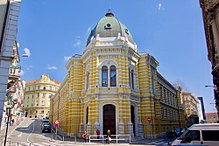
Italian is widely taught in many schools around the world, but rarely as the first foreign language. In the 21st century, technology also allows for the continual spread of the Italian language, as people have new ways to learn how to speak, read, and write languages at their own pace and at any given time. For example, the free website and application Duolingo has 4.94 million English speakers learning the Italian language.
According to the Italian Ministry of Foreign Affairs, every year there are more than 200,000 foreign students who study the Italian language; they are distributed among the 90 Institutes of Italian Culture that are located around the world, in the 179 Italian schools located abroad, or in the 111 Italian lecturer sections belonging to foreign schools where Italian is taught as a language of culture.
As of 2022, Australia had the highest number of students learning Italian in the world. This occurred because of support by the Italian community in Australia and the Italian Government and also because of successful educational reform efforts led by local governments in Australia.
Influence and derived languages
See also: Italian diaspora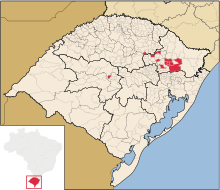

From the late 19th to the mid-20th century, thousands of Italians settled in Argentina, Uruguay, southern Brazil and Venezuela, as well as in Canada and the United States, where they formed a physical and cultural presence.
In some cases, colonies were established where variants of regional languages of Italy were used, and some continue to use this regional language. Examples are Rio Grande do Sul, Brazil, where Talian is used, and the town of Chipilo near Puebla, Mexico; each continues to use a derived form of Venetian dating back to the nineteenth century. Another example is Cocoliche, an Italian–Spanish pidgin once spoken in Argentina and especially in Buenos Aires, and Lunfardo.
Lingua franca
See also: Mediterranean Lingua FrancaStarting in late medieval times in much of Europe and the Mediterranean, Latin was replaced as the primary commercial language by Italian language variants (especially Tuscan and Venetian). These variants were consolidated during the Renaissance with the strength of Italy and the rise of humanism and the arts.
During that period, Italy held artistic sway over the rest of Europe. It was the norm for all educated gentlemen to make the Grand Tour, visiting Italy to see its great historical monuments and works of art. It thus became expected to learn at least some Italian. In England, while the classical languages Latin and Greek were the first to be learned, Italian became the second most common modern language after French, a position it held until the late 18th century when it tended to be replaced by German. John Milton, for instance, wrote some of his early poetry in Italian.
Within the Catholic Church, Italian is known by a large part of the ecclesiastical hierarchy and is used in substitution for Latin in some official documents.
Italian loanwords continue to be used in most languages in matters of art and music (especially classical music including opera), in the design and fashion industries, in some sports such as football and especially in culinary terms.
See also
- Demographics of Italy
- Sicilians
- Sardinians
- Ladins
- List of Italians
- List of Sardinians
- List of Sicilians
- Sammarinese
Notes
- Italian is the main language of the valleys of Calanca, Mesolcina, Bregaglia and val Poschiavo. In the village of Maloja, it is spoken by about half the population. It is also spoken by a minority in the village of Bivio.
References
- ^ "Indicatori demografici Istat (Italian)" (PDF). Archived (PDF) from the original on 15 November 2018. Retrieved 14 November 2018.
- "Sono circa 80 milioni gli oriundi italiani nel mondo" (in Italian). 4 February 2020. Archived from the original on 10 November 2021. Retrieved 10 November 2021.
- "República Italiana". itamaraty.gov.br. Archived from the original on 25 October 2019. Retrieved 25 December 2019.
- "Rapporto italiani nel mondo" (PDF). Progetto culturale (in Italian). Archived (PDF) from the original on 15 December 2013. Retrieved 13 December 2013.
- ^ "Italiani nel Mondo: diaspora italiana in cifre" [Italians in the World: Italian diaspora in figures] (PDF) (in Italian). Migranti Torino. 30 April 2004. Archived from the original (PDF) on 27 February 2008. Retrieved 22 September 2012.
- "Rapporto italiani nel mondo" (PDF). Progetto culturale (in Italian). Archived (PDF) from the original on 15 December 2013. Retrieved 13 December 2013.
- ^ Departamento de Derecho y Ciencias Políticas de la Universidad Nacional de La Matanza (14 November 2011). "Historias de inmigrantes italianos en Argentina". infouniversidades.siu.edu.ar (in Spanish). Archived from the original on 26 December 2021. Retrieved 15 November 2018.
Se estima que en la actualidad, el 90% de la población argentina tiene alguna ascendencia europea y que al menos 25 millones están relacionados con algún inmigrante de Italia.
- "Total ancestry categories tallied for people with one or more ancestry categories reported 2010 American Community Survey 1-Year Estimates". United States Census Bureau. Archived from the original on 18 January 2015. Retrieved 30 November 2012.
- "The United States-Italy Relationship and Transatlantic Unity". U.S. Department of State. 27 June 2021. Archived from the original on 29 July 2022. Retrieved 29 July 2022.
- "Who We Are – The National Italian American Foundation". Archived from the original on 4 December 2022. Retrieved 4 December 2022.
- Gambino, Richard (30 April 1972). "Twenty Million Italian-Americans". The New York Times. Archived from the original on 3 January 2023. Retrieved 3 January 2023.
- "Rapporto Italiani nel Mondo 2023" (PDF). migrantes.it. Archived (PDF) from the original on 16 December 2023. Retrieved 4 January 2023.
- "Documento "Italiens" del CIRCE dell'Università Sorbona – Parigi 3" (PDF). Archived (PDF) from the original on 28 August 2022. Retrieved 22 March 2021.
- Cohen, Robin (1995). Cambridge Survey. Cambridge University Press. p. 143. ISBN 9780521444057. Retrieved 11 May 2009.
5 million italians in france.
- "Ya se puede sacar la nacionalidad italiana". ABC Color. Archived from the original on 19 June 2020. Retrieved 29 May 2020.
- "Convenzioni Inps estere, Fedi sollecita Nuova Zelanda ma anche Cile e Filippine". 9 February 2018. Archived from the original on 9 February 2018. Retrieved 31 March 2021.
- Government of Canada, Statistics Canada (26 October 2022). "Ethnic or cultural origin by generation status: Canada, provinces and territories, census metropolitan areas and census agglomerations with parts". www12.statcan.gc.ca. Archived from the original on 26 October 2022. Retrieved 26 October 2022.
- ^ "Los árboles sin raíces, mueren" (in Spanish). 30 October 2006. Archived from the original on 4 March 2016. Retrieved 31 October 2023.
- "Italianos celebran en Venezuela los 150 años de la Unificación". El Universal. Archived from the original on 4 March 2016. Retrieved 10 July 2015.
- Notargiovanni, Caterina (2017). "Por qué tantos en Venezuela están eligiendo Italia para huir de la crisis" (in Spanish). BBC. Archived from the original on 12 December 2018. Retrieved 31 March 2021.
"Estimamos que hay 2 millones de descendientes de italianos en Venezuela", le explica a BBC Mundo el primer secretario Lorenzo Solinas, encargado de prensa de la Embajada de Italia en Caracas.
- Scalzotto, Davide. "Noi veneti del Venezuela, siamo i nuovi profughi fantasma". Il Gazzettino (in Italian). Archived from the original on 14 November 2021. Retrieved 10 May 2021.
I veneti in Venezuela sono invece 5 milioni: un quinto della popolazione.
- Notargiovanni, Caterina (2023). "Diáspora de italianos en América Latina: ¿cuál es el país al otro lado del Atlántico con más descendientes?" (in Spanish). ahoraroma. Archived from the original on 25 March 2024. Retrieved 22 October 2023.
"En Argentina, la comunidad italo-argentina también es significativa, con aproximadamente 25 millones de descendientes italianos" Según distintos informes, le siguen, Venezuela (2 millones), Uruguay (1,5 millones) y Canadá (1,4 millones).
- Notargiovanni, Caterina (2023). ""Gli italiani in Venezuela stanno con Guaidò": la crisi raccontata dai 500mila italiani nel paese" (in Italian). tpi.it. Archived from the original on 25 March 2024. Retrieved 31 March 2021.
Con 200mila persone iscritte all'Aire e 500mila conteggiate in tutto sul territorio, gli italiani sono la più grande comunità presente a Caracas.
- "Community profiles 2021". Archived from the original on 28 June 2022. Retrieved 30 December 2022.
- "ABS Ancestry". 2012. Archived from the original on 1 July 2016. Retrieved 12 October 2014.
- ^ "PARTE QUINTA ALLEGATI SOCIO-STATISTICI" (PDF). Archived (PDF) from the original on 28 January 2022. Retrieved 14 February 2022.
- Parvex R. (2014). Le Chili et les mouvements migratoires Archived 1 August 2020 at the Wayback Machine, Hommes & migrations, Nº 1305, 2014. doi:10.4000/hommesmigrations.2720 Archived 27 September 2023 at the Wayback Machine.
- Perú, Redacción El Comercio (27 September 2017). "Embajador de Italia: "Acá hay muchas oportunidades para nuestras empresas"". El Comercio. Archived from the original on 22 December 2019. Retrieved 22 December 2019.
- "Vreemde afkomst 01/01/2012". Npdata.be. Archived from the original on 8 September 2012. Retrieved 29 March 2015.
- Ramírez, Kevin (11 June 2012). "Costa Rica e Italia: países unidos por la historia y la cultura". Distance State University (in Spanish). Archived from the original on 8 January 2017. Retrieved 12 August 2022.
- "Italianos en España" (PDF). Archived from the original (PDF) on 1 April 2021. Retrieved 14 February 2022.
- "Population of the United Kingdom by country of birth and nationality, July 2020 to June 2021". ons.gov.uk. Office for National Statistics. Archived from the original on 3 January 2024. Retrieved 5 February 2023..
- "Episodio 10: Italianos". Canal Once. Archived from the original on 5 March 2016. Retrieved 6 July 2015.
- "Le comunità italiane in Cile ed Ecuador — Lombardi nel Mondo". portale.lombardinelmondo.org. Archived from the original on 16 April 2014.
- "ФМС России". Fms.gov.ru. Archived from the original on 30 April 2016. Retrieved 12 December 2017.
- "San Marino country profile". BBC News. 18 May 2018. Archived from the original on 14 June 2018. Retrieved 18 May 2018.
- Relatório de Imigração, Fronteiras e Asilo (PDF), Serviço de Estrangeiros e Fronteiras, archived (PDF) from the original on 23 June 2022, retrieved 28 May 2023
- ^ "12. Population by ethnicity, by towns/municipalities, census 2001". Census of Population, Households and Dwellings 2001. Zagreb: Croatian Bureau of Statistics. 2002. Retrieved 23 August 2019.
- "Italians looking for work in Albania – 19,000, says minister". ANSAmed. 15 May 2014. Archived from the original on 12 June 2014. Retrieved 14 June 2014.
- "Emigrazione italiana a Dubai" (in Italian). 10 November 2022. Archived from the original on 22 March 2024. Retrieved 22 March 2024.
- redazione. "Z miesiąca na miesiąc rośnie liczba Włochów w Polsce". Nasz Swiat (in Polish). Archived from the original on 16 February 2022. Retrieved 16 February 2022.
- "House of Italy". The Cloud. 8 February 2021. Archived from the original on 13 June 2021. Retrieved 2 May 2021.
- "L'Italia e le religioni nel 2016". Italofilia.Pl. 12 November 2016. Archived from the original on 22 July 2019. Retrieved 12 November 2016.
- "Religion in Italy: History and Statistics". Archived from the original on 12 September 2022. Retrieved 12 September 2022.
- European Commission (June 2012). Special Eurobarometer 386: Europeans and Their Languages (PDF) (Report). Eurobarometer Special Surveys. Archived from the original (PDF) on 6 January 2016. Retrieved 12 February 2015.
- "Malta Skills Survey 2022 - Preliminary Report" (PDF). nso.gov.mt. Malta National Statistics Office. 15 June 2023. p. 40. Archived (PDF) from the original on 17 June 2023. Retrieved 20 June 2023.
- Minahan, James (2000). One Europe, Many Nations: A Historical Dictionary of European National Groups. Greenwood Publishing Group. pp. 342–343. ISBN 0313309841. Archived from the original on 21 March 2015. Retrieved 21 August 2023.
- Miti e simboli della rivoluzione nazionale Archived 10 August 2018 at the Wayback Machine. Treccani.it
- Ethnic and Cultural Diversity by Country, James D. Fearon Archived 13 November 2018 at the Wayback Machine. Department of Political Science, Stanford University
- ^ : The usage of Italian language, dialects and other languages in Italy Archived 10 December 2018 at the Wayback Machine. Istat.it
- Giuliano Procacci (ed.) (2009) Storia degli Italiani (In Italian: History of the Italian People). Rome, Italy: Editori Laterza.
- "Criteria underlying legislation concerning citizenship". Italian Ministry of Interior. Archived from the original on 22 June 2012. Retrieved 22 September 2012.
- Ruggiero Romano, Corrado Vivanti, (1972). 'I caratteri originali'. In: Giulio Einaudi Editore (ed), Storia d'Italia Einaudi. 1st ed. Torino: Einaudi. pp.958–959.
- ^ "Italy, Languages – Encyclopædia Britannica". britannica.com. Archived from the original on 12 July 2018. Retrieved 7 November 2018.
- ^ "What languages are spoken in Italy?". worldatlas.com. Archived from the original on 15 January 2019. Retrieved 7 November 2018.
- ^ "The usage of Italian language, dialects and other languages in Italy". istat.it. 30 October 2016. Archived from the original on 4 January 2018. Retrieved 3 January 2018.
- ^ Maiden, Dr. Martin; Parry, Mair (7 March 2006). The Dialects of Italy. Routledge. p. 2. ISBN 9781134834365. Archived from the original on 9 January 2020. Retrieved 7 February 2017.
- ^ "UNESCO Atlas of the World's Languages in danger". unesco.org. Archived from the original on 18 December 2016. Retrieved 7 November 2018.
- "Foreign citizens 2017". ISTAT. Archived from the original on 6 August 2017. Retrieved 15 June 2018.
- "Italian — University of Leicester". .le.ac.uk. Archived from the original on 2 May 2014. Retrieved 22 October 2015.
- Cohen, Robin (1995). The Cambridge survey of world migration. Cambridge: Cambridge University Press. pp. 142–144. ISBN 0-521-44405-5.
- "Italiani nel Mondo". esteri.it. Archived from the original on 22 March 2020. Retrieved 11 March 2020.
- "Rapporto Italiani nel Mondo 2010" (PDF). Progettoculturale.it. Archived (PDF) from the original on 25 May 2017. Retrieved 12 December 2017.
- Bridger, Gordon A. (2013). Britain and the Making of Argentina. WIT Press. p. 101. ISBN 9781845646844. Archived from the original on 27 October 2023. Retrieved 25 September 2021.
Some 86% identify themselves as being of European descent, of whom 60% would claim Italian links
- Marcello De Cecco. "La Argentina y los Europeos sin Europa". Zingerling (in Spanish). Archived from the original on 26 June 2017. Retrieved 24 November 2020.
- ^ "Brazil – the Country and its People" (PDF). www.brazil.org.uk. Archived from the original (PDF) on 21 October 2014. Retrieved 20 December 2014.
- Keating, Michael (2004). Regions and regionalism in Europe. Cheltenham: Edward Elgar Publishing. p. 378. ISBN 1-84376-127-0. Archived from the original on 24 April 2016. Retrieved 12 December 2015.
- Barone, Michael (2 September 2010). "The essence of Italian culture and the challenge of the global age". Council for Research in Values and philosophy. Archived from the original on 22 September 2012. Retrieved 22 September 2012.
- Macesich, George (2000). Issues in Money and Banking. United States: Greenwood Publishing Group. p. 42. ISBN 0-275-96777-8. Archived from the original on 15 September 2015. Retrieved 29 October 2015.
- Related Articles (2 January 2009). "Italian cuisine". Britannica Online Encyclopedia. Britannica.com. Archived from the original on 16 July 2010. Retrieved 24 April 2010.
- Cocco, Sean (29 November 2012). Watching Vesuvius: A History of Science and Culture in Early Modern Italy. University of Chicago Press. ISBN 9780226923710. Archived from the original on 23 August 2019. Retrieved 16 September 2019.
- Peter Bondanella (2009). A History of Italian Cinema. A&C Black. ISBN 9781441160690. Archived from the original on 1 April 2019. Retrieved 16 September 2019.
- Alberto Manco, Italia. Disegno storico-linguistico, 2009, Napoli, L'Orientale, ISBN 978-8-8950-4462-0
- J.P. Mallory and D.Q. Adams, Encyclopedia of Indo-European Culture (London: Fitzroy and Dearborn, 1997), 24.
- Dionysius of Halicarnassus, Roman Antiquities, 1.35 Archived 15 December 2022 at the Wayback Machine, on LacusCurtius; Aristotle, Politics, 7.1329b Archived 10 September 2015 at the Wayback Machine, on Perseus; Thucydides, The Peloponnesian War, 6.2.4 Archived 24 September 2015 at the Wayback Machine, on Perseus
- Pallottino, M., History of Earliest Italy, trans. Ryle, M & Soper, K. in Jerome Lectures, Seventeenth Series, p. 50
- Giovanni Brizzi, Roma. Potere e identità: dalle origini alla nascita dell'impero cristiano, Bologna, Patron, 2012 p. 94
- Carlà-Uhink, Filippo (25 September 2017). The "Birth" of Italy: The Institutionalization of Italy as a Region, 3rd–1st Century BCE. Walter de Gruyter GmbH & Co KG. ISBN 978-3-1105-4478-7.; Levene, D. S. (17 June 2010). Livy on the Hannibalic War. Oxford University Press. ISBN 978-0-1981-5295-8. Archived from the original on 28 March 2024. Retrieved 12 November 2020.
- Carlà-Uhink, Filippo (25 September 2017). The "Birth" of Italy: The Institutionalization of Italy as a Region, 3rd–1st Century BCE. Walter de Gruyter GmbH & Co KG. ISBN 978-3-1105-4478-7. Archived from the original on 11 February 2024. Retrieved 12 November 2020.
- Williams, J. H. C. (22 May 2020). Beyond the Rubicon: Romans and Gauls in Republican Italy – J. H. C. Williams – Google Books. Oxford University Press. ISBN 978-0-1981-5300-9. Archived from the original on 22 May 2020.; Long, George (1866). Decline of the Roman republic: Volume 2.; Aurigemma, Salvatore. "Gallia Cisalpina". treccani.it (in Italian). Enciclopedia Italiana. Archived from the original on 4 April 2023. Retrieved 14 October 2014.
- "Italy (ancient Roman territory)". Encyclopædia Britannica. Archived from the original on 10 November 2013. Retrieved 10 November 2013.
- "La riorganizzazione amministrativa dell'Italia. Costantino, Roma, il Senato e gli equilibri dell'Italia romana" (in Italian). Archived from the original on 19 November 2021. Retrieved 19 November 2021.
- Letters 9.23
- ytaliiens (1265) TLFi Archived 29 October 2018 at the Wayback Machine
- "IL COMUNE MEDIEVALE". homolaicus.com. Archived from the original on 18 March 2012.
- ..."L'Italia è, dal punto di vista genetico, un mosaico di gruppi etnici ben differenziati." Alberto Piazza, I profili genetici degli italiani Archived 10 May 2019 at the Wayback Machine, Accademia delle Scienze di Torino
- Raveane, Alessandro; Montinaro, Francesco; Capelli, Cristian (2019). "Un ritratto genetico degli italiani". Scienza in rete. Archived from the original on 2 November 2019. Retrieved 4 November 2019.
- Pina Polo, Francisco (2009). "Deportation of Indigenous Population as a Strategy for Roman Dominion in Hispania". In Morillo, Ángel; Hanel, Norbert; Martín, Esperanza (eds.). Limes XX – 20th International Congress of Roman Frontier Studies, Leon 2006. Anejos de Gladius; 13.1. Vol. 1. Madrid: Ediciones Polifemo. pp. 281–8. ISBN 9788400088545. Archived from the original on 19 October 2017. Retrieved 3 December 2017.
- "Gaul | ancient region, Europe | Britannica". www.britannica.com. Archived from the original on 26 May 2022. Retrieved 27 May 2022.
- "Senigallia | Italy | Britannica". www.britannica.com. Archived from the original on 4 June 2022. Retrieved 27 May 2022.
- Raveane, Alessandro; Molinaro, Ludovica; Aneli, Serena; Capodiferro, Marco Rosario; Ongaro, Linda; Migliore, Nicola Rambaldi; Soffiati, Sara; Scarano, Teodoro; Torroni, Antonio; Achilli, Alessandro; Ventura, Mario (1 March 2022). "Assessing temporal and geographic contacts across the Adriatic Sea through the analysis of genome-wide data from Southern Italy": 2022.02.26.482072. doi:10.1101/2022.02.26.482072. S2CID 247231413. Archived from the original on 24 April 2022. Retrieved 11 April 2022.
{{cite journal}}: Cite journal requires|journal=(help) - ^ Sarno, Stefania; Boattini, Alessio; Pagani, Luca; Sazzini, Marco; De Fanti, Sara; Quagliariello, Andrea; Gnecchi Ruscone, Guido Alberto; Guichard, Etienne; Ciani, Graziella; Bortolini, Eugenio; Barbieri, Chiara (16 May 2017). "Ancient and recent admixture layers in Sicily and Southern Italy trace multiple migration routes along the Mediterranean". Scientific Reports. 7 (1): 1984. Bibcode:2017NatSR...7.1984S. doi:10.1038/s41598-017-01802-4. ISSN 2045-2322. PMC 5434004. PMID 28512355.
- ^ Raveane, A.; Aneli, S.; Montinaro, F.; Athanasiadis, G.; Barlera, S.; Birolo, G.; Boncoraglio, G.; Di Blasio, A. M.; Di Gaetano, C.; Pagani, L.; Parolo, S. (6 September 2019). "Population structure of modern-day Italians reveals patterns of ancient and archaic ancestries in Southern Europe". Science Advances. 5 (9): eaaw3492. Bibcode:2019SciA....5.3492R. doi:10.1126/sciadv.aaw3492. ISSN 2375-2548. PMC 6726452. PMID 31517044.
- Sarno, S; Boattini, A; Carta, M; Ferri, G; Alù, M; Yao, DY; Ciani, G; Pettener, D; Luiselli, D (2014). "An Ancient Mediterranean Melting Pot: Investigating the Uniparental Genetic Structure and Population History of Sicily and Southern Italy". PLOS ONE. 9 (4): e96074. Bibcode:2014PLoSO...996074S. doi:10.1371/journal.pone.0096074. PMC 4005757. PMID 24788788.
 This article contains quotations from this source, which is available under a Creative Commons Attribution 4.0 International (CC BY 4.0) license.
This article contains quotations from this source, which is available under a Creative Commons Attribution 4.0 International (CC BY 4.0) license.
- Capelli, Cristian; Onofri, Valerio; Brisighelli, Francesca; Boschi, Ilaria; Scarnicci, Francesca; Masullo, Mara; Ferri, Gianmarco; Tofanelli, Sergio; Tagliabracci, Adriano; Gusmao, Leonor; Amorim, Antonio (June 2009). "Moors and Saracens in Europe: estimating the medieval North African male legacy in southern Europe". European Journal of Human Genetics. 17 (6): 848–852. doi:10.1038/ejhg.2008.258. ISSN 1018-4813. PMC 2947089. PMID 19156170.
- Fiorito, Giovanni; Di Gaetano, Cornelia; Guarrera, Simonetta; Rosa, Fabio; Feldman, Marcus W.; Piazza, Alberto; Matullo, Giuseppe (July 2016). "The Italian genome reflects the history of Europe and the Mediterranean basin". European Journal of Human Genetics. 24 (7): 1056–1062. doi:10.1038/ejhg.2015.233. ISSN 1476-5438. PMC 5070887. PMID 26554880. S2CID 6621338.
- Marcus JH, Posth C, Ringbauer H, Lai L, Skeates R, Sidore C, et al. (February 2020). "Genetic history from the Middle Neolithic to present on the Mediterranean island of Sardinia". Nature Communications. 11 (1): 939. Bibcode:2020NatCo..11..939M. doi:10.1038/s41467-020-14523-6. PMC 7039977. PMID 32094358
- «Sicily and Southern Italy were heavily colonized by Greeks beginning in the eight to ninth century B.C.. The demographic development of the Greek colonies in Southern Italy was remarkable, and in classical times this region was called Magna Graecia (Great Greece) because it probably surpassed in numbers the Greek population of the motherland.» Cavalli-Sforza L, Menozzi P, Piazza A (1994). The History and Geography of Human Genes. Princeton University Press. p. 278. ISBN 978-0-691-08750-4. Archived from the original on 27 October 2023. Retrieved 2 June 2021.
- Haak W, Lazaridis I, Patterson N, Rohland N, Mallick S, Llamas B, et al. (June 2015). "Massive migration from the steppe was a source for Indo-European languages in Europe". Nature. 522 (7555): 207–11. arXiv:1502.02783. Bibcode:2015Natur.522..207H. doi:10.1038/nature14317. PMC 5048219. PMID 25731166.
- Di Gaetano C, Voglino F, Guarrera S, Fiorito G, Rosa F, Di Blasio AM, et al. (2012). "An overview of the genetic structure within the Italian population from genome-wide data". PLOS ONE. 7 (9): e43759. Bibcode:2012PLoSO...743759D. doi:10.1371/journal.pone.0043759. PMC 3440425. PMID 22984441
- Price AL, Butler J, Patterson N, Capelli C, Pascali VL, Scarnicci F, et al. (January 2008). "Discerning the ancestry of European Americans in genetic association studies". PLOS Genetics. 4 (1): e236. doi:10.1371/journal.pgen.0030236. PMC 2211542. PMID 18208327.
- Paschou P, Drineas P, Yannaki E, Razou A, Kanaki K, Tsetsos F, et al. (June 2014). "Maritime route of colonization of Europe". Proceedings of the National Academy of Sciences of the United States of America. 111 (25): 9211–6. Bibcode:2014PNAS..111.9211P. doi:10.1073/pnas.1320811111. PMC 4078858. PMID 24927591
- ^ Haak, Wolfgang; Lazaridis, Iosif; Patterson, Nick; Rohland, Nadin; Mallick, Swapan; Llamas, Bastien; Brandt, Guido; Nordenfelt, Susanne; Harney, Eadaoin; Stewardson, Kristin; Fu, Qiaomei (11 June 2015). "Massive migration from the steppe was a source for Indo-European languages in Europe". Nature. 522 (7555): 207–211. arXiv:1502.02783. Bibcode:2015Natur.522..207H. doi:10.1038/nature14317. ISSN 0028-0836. PMC 5048219. PMID 25731166.
- Posth, C., Yu, H., Ghalichi, A. (2023). "Palaeogenomics of Upper Palaeolithic to Neolithic European hunter-gatherers". Nature. 615 (2 March 2023): 117–126. Bibcode:2023Natur.615..117P. doi:10.1038/s41586-023-05726-0. PMC 9977688. PMID 36859578.
{{cite journal}}: CS1 maint: multiple names: authors list (link) - Gibbons, Ann (21 February 2017). "Thousands of horsemen may have swept into Bronze Age Europe, transforming the local population". Science. Archived from the original on 25 September 2022. Retrieved 25 March 2023.
- Dupanloup I, Bertorelle G, Chikhi L, Barbujani G (July 2004). "Estimating the impact of prehistoric admixture on the genome of Europeans". Molecular Biology and Evolution. 21 (7): 1361–72. doi:10.1093/molbev/msh135. PMID 15044595.
- Venceslas Kruta: La grande storia dei celti. La nascita, l'affermazione e la decadenza, Newton & Compton, 2003, ISBN 88-8289-851-2, ISBN 978-88-8289-851-9
- Marzatico, Franco (19 August 2004). Menotti, Francesco (ed.). Living on the Lake in Prehistoric Europe: 150 Years of Lake-Dwelling Research. Routledge. pp. 83–84. ISBN 978-1-134-37181-5. Archived from the original on 10 December 2016. Retrieved 10 July 2016.
- Saupe, Tina; Montinaro, Francesco; Scaggion, Cinzia; Carrara, Nicola; Kivisild, Toomas; D'Atanasio, Eugenia; Hui, Ruoyun; Solnik, Anu; Lebrasseur, Ophélie; Larson, Greger; Alessandri, Luca (21 June 2021). "Ancient genomes reveal structural shifts after the arrival of Steppe-related ancestry in the Italian Peninsula". Current Biology. 31 (12): 2576–2591.e12. Bibcode:2021CBio...31E2576S. doi:10.1016/j.cub.2021.04.022. hdl:11585/827581. ISSN 0960-9822. PMID 33974848. S2CID 234471370.
- Aneli, Serena; Caldon, Matteo; Saupe, Tina; Montinaro, Francesco; Pagani, Luca (1 October 2021). "Through 40,000 years of human presence in Southern Europe: the Italian case study". Human Genetics. 140 (10): 1417–1431. doi:10.1007/s00439-021-02328-6. ISSN 1432-1203. PMC 8460580. PMID 34410492. Archived from the original on 27 October 2023. Retrieved 12 January 2022.
- Saupe et al. 2021 "The results suggest that the Steppe-related ancestry component could have first arrived through Late N/Bell Beaker groups from Central Europe."
- Kruta, Venceslas (1991). The Celts. Thames and Hudson. pp. 89–102.
- Stifter, David (2008). Old Celtic Languages - Addenda. p. 25.
- "Home - Ryan Setliff Online". www.ryansetliff.online. Archived from the original on 8 April 2022. Retrieved 20 March 2022.
- Vitali, Daniele (1996). "Manufatti in ferro di tipo La Tène in area italiana : le potenzialità non-sfruttate". Mélanges de l'École Française de Rome. Antiquité. 108 (2): 575–605. doi:10.3406/mefr.1996.1954. Archived from the original on 24 September 2015. Retrieved 10 April 2022.
- Prichard, James Cowles (1826). Researches Into the Physical History of Mankind: In Two Volumes. John and Arthur Arch, Cornhill. p. 60. Archived from the original on 10 December 2016. Retrieved 3 July 2016.
- McNair, Raymond F. (22 March 2012). Key to Northwest European Origins. Author House. p. 81. ISBN 978-1-4685-4600-2.
- Hazlitt, William (1851). The Classical Gazetteer: A Dictionary of Ancient Geography, Sacred and Profane. Whittaker. p. 297. Retrieved 3 July 2016.
- "A spasso nel tempo: passeggiando tra le millenarie vestigia di Canusium". iltaccodibacco.it (in Italian). Archived from the original on 23 March 2023. Retrieved 20 March 2022.
- Nicholas Hammond, Howard Scullard. Dizionario di antichità classiche. Milano, Edizioni San Paolo, 1995, p.1836-1836. ISBN 88-215-3024-8.
- "Elmo Celtico". Archeologia Gallia Cisalpina (in Italian). Archived from the original on 1 February 2023. Retrieved 20 March 2022.
- Cornell, T. J. (1995): The Beginning of Rome. p43
- Goring, Elizabeth (2004). Treasures from Tuscany: the Etruscan legacy. Edinburgh: National Museums Scotland Enterprises Limited. p. 13. ISBN 978-1901663907.
- Leighton, Robert (2004). Tarquinia. An Etruscan City. Duckworth Archaeological Histories Series. London: Duckworth Press. p. 32. ISBN 0-7156-3162-4.
- Camporeale, Giovannangelo, ed. (2001). The Etruscans Outside Etruria. Translated by Hartmann, Thomas Michael. Los Angeles: Getty Trust Publications (published 2004).
- "Etruria campana". Archived from the original on 14 December 2021. Retrieved 23 December 2021.
- Strabo, Geographica, V (Italia), 4.3.
- Francesco Belsito (2013). Storia di Nocera. Monumenti, personaggi, leggende. Angri, Gaia.
- Samuel Edward Finer, The History of Government from the Earliest Times, Oxford University Press, 1999, p. 398
- Ghirotto S, Tassi F, Fumagalli E, Colonna V, Sandionigi A, Lari M, et al. (2013). "Origins and Evolution of the Etruscans' mtDNA". PLOS ONE. 8 (2): e55519. Bibcode:2013PLoSO...855519G. doi:10.1371/journal.pone.0055519. PMC 3566088. PMID 23405165.
- Tassi F, Ghirotto S, Caramelli D, Barbujani G, et al. (2013). "Genetic evidence does not support an Etruscan origin in Anatolia". American Journal of Physical Anthropology. 152 (1): 11–18. doi:10.1002/ajpa.22319. PMID 23900768.
- Leonardi, Michela; Sandionigi, Anna; Conzato, Annalisa; Lari, Martina; Tassi, Francesca (2018). "The female ancestor's tale: Long-term matrilineal continuity in a nonisolated region of Tuscany". American Journal of Physical Anthropology. 167 (3): 497–506. doi:10.1002/ajpa.23679. PMID 30187463. S2CID 52161000.
- "Were the Etruscans after all native Italians?". For what they were... we are – Prehistory, Anthropology and Genetics. 8 February 2013. Archived from the original on 13 July 2015. Retrieved 25 April 2015.
- Antonio, Margaret L.; Gao, Ziyue; M. Moots, Hannah (2019). "Ancient Rome: A genetic crossroads of Europe and the Mediterranean". Science. 366 (6466). Washington D.C.: American Association for the Advancement of Science (published 8 November 2019): 708–714. Bibcode:2019Sci...366..708A. doi:10.1126/science.aay6826. hdl:2318/1715466. PMC 7093155. PMID 31699931.
Interestingly, although Iron Age individuals were sampled from both Etruscan (n=3) and Latin (n=6) contexts, we did not detect any significant differences between the two groups with f4 statistics in the form of f4(RMPR_Etruscan, RMPR_Latin; test population, Onge), suggesting shared origins or extensive genetic exchange between them.
- Posth, Cosimo; Zaro, Valentina; Spyrou, Maria A. (24 September 2021). "The origin and legacy of the Etruscans through a 2000-year archeogenomic time transect". Science Advances. 7 (39). Washington DC: American Association for the Advancement of Science: eabi7673. Bibcode:2021SciA....7.7673P. doi:10.1126/sciadv.abi7673. PMC 8462907. PMID 34559560.
- Homo, Léon (1996). Primitive Italy. Routledge. p. 45. ISBN 9780415155809.
- Karl Viktor Müllenhoff, Deutsche Alterthurnskunde, I volume.
- ^ Strabo, Geography, book 2, chapter 5, section 28.
- Dominique François Louis Roget de Belloguet, Ethnogénie gauloise, ou Mémoires critiques sur l'origine et la parenté des Cimmériens, des Cimbres, des Ombres, des Belges, des Ligures et des anciens Celtes. Troisiéme partie: Preuves intellectuelles. Le génie gaulois, Paris 1868.
- Gilberto Oneto Paesaggio e architettura delle regioni padano-alpine dalle origini alla fine del primo millennio, Priuli e Verlucc, editori 2002, pp. 34–36, 49.
- See, in particular McEvedy, Colin (1967). The Penguin Atlas of Ancient History by Colin McEvedy. p. 29.
- Leonard Robert Palmer, The Latin Language, London: Faber and Faber, 1954, p. 54
- Sciarretta, Antonio (2010). Toponomastica d'Italia. Nomi di luoghi, storie di popoli antichi. Milano: Mursia. pp. 174–194. ISBN 978-88-425-4017-5.
- According, among others, to: Prosdocimi, Aldo Luigi (1993). Popoli e civiltà dell'Italia antica (in Italian). Vol. 6/1. Spazio Tre. Cf. Villar, Francisco (2008). Gli Indoeuropei e le origini dell'Europa (in Italian). Il Mulino. p. 490.
- "Venetoimage – Canova e Possagno". Venetoimage.com. Archived from the original on 25 May 2017. Retrieved 12 December 2017.
- (C. Plinii, Naturalis Historia, III, 68–69)
- The Saylor Foundation. "The Ancient People of Italy" (PDF). Saylor.org. Archived (PDF) from the original on 6 November 2015. Retrieved 19 September 2015.
- Hayden, Olivia E. "Urban Planning in the Greek Colonies in Sicily and Magna Graecia". Tufts University, 2013. Archived from the original on 25 September 2015. Retrieved 23 September 2015.
- P. A. Brunt, Italian manpower, 225 B.C.-A.D. 14, Oxford University Press, 1971, p. 52
- ^ La popolazione del Mondo Greco-Romano, Karl Julius Beloch
- Dictionary of Greek and Roman Geography, Vol. 1, Boston: Little, Brown, and Company. 1854. p. 4
- Luuk De Ligt, Peasants, Citizens and Soldiers: Studies in the Demographic History of Roman Italy 225 BC – AD 100. Cambridge; New York: Cambridge University Press, 2012. p. 43-44
- Pliny the Elder III.20
- Livy V.33
- Cambridge Anthropology, Vol. 6, 1980, p. 60
- ^ "LaGrandeBiblioteca.com is available at DomainMarket.com". LaGrandeBiblioteca.com is available at DomainMarket.com. Archived from the original on 2 February 2020. Retrieved 29 January 2020.
- A Dictionary of Greek and Roman Biography and Mythology, Vol. 3, London. John Murray: printed by Spottiswoode and Co., New-Street Square and Parliament Streetp. 661
- M. Rostovtzeff, A History of the Ancient World: Rome, Vol. II, Oxford: Clarendon Press, 1927, p. 171
- Alfred S. Bradford, With Arrow, Sword, and Spear: A History of Warfare in the Ancient World, Praeger Publishers, 2001, p. 191
- ^ Strabo, Geography, book 5, chapter 10
- Strabo, Geography, book 5, chapter 6
- Staveley, ES (1989). "Rome and Italy in the Early Third Century". In Walbank, Frank William (ed.). The Cambridge Ancient History. Vol. VII: the Hellenistic World: Part 2: The Rise of Rome to 220 BC. Cambridge: Cambridge University Press. p. 425.
Certainly, steps designed to consolidate her hold in the north-east followed this incident in quick succession: the foundation in 268 of the Latin colony of Ariminum .... the annexation of the whole Picentine land save for … Ancona and … Asculum; the transportation of large numbers of Picentes to the ager Picentinus on the west coast, and finally in 264 the planting of a second large Latin colony on the coast at Firmum.
- Ettore Pais, Ancient Italy: Historical and Geographical Investigations in Central Italy, Magna Graecia, Sicily, and Sardinia, The University of Chicago Press, 1908
- Patrick Bruun, Studies in the romanization of Etruria, Vol. 1–7, p. 101
- Jordanes, Getica 243
- Ammianus Marcellinus, Res Gestae 28,5,15
- ^ Paul, Vauthier Adams (3 August 2000). Experiencing World History. NYU Press.
- Ward-Perkins, Bryan (2006). The Fall of Rome: And the End of Civilization. Oxford: Oxford University Press. p. 31. ISBN 978-0-19-280564-5.
- Frank N. Magill, The Middle Ages: Dictionary of World Biography, Volume 2, Salem Press, Inc. 1998, p. 895.
- William A. Sumruld, Augustine and the Arians: The Bishop of Hippo's Encounters with Ulfilan Arianism, Associated Press University Presses 1994, p. 23.
- Delbr_ck, Hans (1990). The barbarian invasions. U of Nebraska Press. p. 286.
- De Bello Gothico IV 32, pp. 241–245; this reference stems from the pen of the Byzantine historian, Procopius, who accompanied Justinian's leading general, Belisarius, on his exploits between 527 and 540. This included the campaigns against the Ostrogoths, which is the subject of De Bello Gothico.
- Antonio Santosuosso, Barbarians, Marauders, and Infidels: The Ways of Medieval Warfare, Westview Press 2004, p. 44.
- Diaconis, Paulus (787). Historia Langobardorum. Monte Cassino, Italy. Book V chapter 29. Archived from the original on 17 May 2008.
- Corbanese, G. G. (1983). Il Friuli, Trieste e l'Istria: dalla Preistoria alla caduta del Patriarcato d'Aquileia (Grande Atlante Cronologico ed.). Udine: Del Bianco.
- G., Barbina (1981). Codroipo (Il ponte ed.).
- Golden, Peter B. (1992). An Introduction to the History of the Turkic Peoples. Wiesbaden: Otto Harrassowitz. p. 245. ISBN 9783447032742. Archived from the original on 15 October 2022. Retrieved 5 December 2022.
- Loud, G. A.; Metcalfe, Alex (2002). "Following the marriage to his third wife, Adelaide, from the Aleramici clan in Piedmont, many northern Italians (the sources refer to them as lombardi, as opposed to the longobardi from southern Italy) settled on the island of Sicily from the late Eleventh century onwards". The Society of Norman Italy. Brill, Leiden: 323. ISBN 9004125418. Archived from the original on 10 June 2016. Retrieved 12 December 2015.
- These Lombard colonisers were natives from Northern Italy and should not be confused with the Lombard Germanic tribe, who were referred to as Longobardi to distinguish them from the locals of the region who were known as Lombardi.
- Jules Gay, L'Italie meridionale et l'empire Byzantin, Parigi 1904, vol. II, p. 450-453.
- David Abulafia, Le due Italie: relazioni economiche fra il regno normanno di Sicilia e i comuni settentrionali, Cambridge University Press 1977 (trad. it. Guida Editori, Napoli 1991), p. 114.
- Kemp, Martin (2003). "Leonardo da Vinci". Grove Art Online. Oxford: Oxford University Press. doi:10.1093/gao/9781884446054.article.T050401. ISBN 978-1-884446-05-4. Archived from the original on 11 March 2021. Retrieved 26 May 2022. (subscription or UK public library membership required)
- Singer, C. (1941). "A Short History of Science to the Nineteenth Century". Clarendon Press: 217. Archived from the original on 26 March 2023. Retrieved 22 March 2023.
{{cite journal}}: Cite journal requires|journal=(help) - Whitehouse, D. (2009). Renaissance Genius: Galileo Galilei & His Legacy to Modern Science. Sterling Publishing. p. 219. ISBN 978-1-4027-6977-1.
- Thomas Hobbes: Critical Assessments, Volume 1. Preston King. 1993. p. 59
- Disraeli, I. (1835). Curiosities of Literature. W. Pearson & Company. p. 371.
- Abulafia, David (2000). Mediterranean encounters, economic, religious, political, 1100–1550. Ashgate Publishing. p. 236. ISBN 0-86078-841-5. Archived from the original on 4 May 2016. Retrieved 12 December 2015.
- Società Siciliana per la Storia Patria. Archivio Storico Siciliano (12 December 1876). "Archivio Storico Siciliano". Palermo. Retrieved 12 December 2017 – via Internet Archive.
- Barone, Francesco (2003). "Islām in Sicilia nel XII e XIII secolo: ortoprassi, scienze religiose e tasawwuf". In Di Bella, Saverio; Tomasello, Dario (eds.). L'Islam in Europa tra passato e futuro. Cosenza: Pellegrini Editore. p. 104. ISBN 88-8101-159-X.
- "History and etymology of Aidone and Morgantina". Italy This Way. Archived from the original on 5 November 2012. Retrieved 22 September 2012.
- According to the most credible hypothesis this settlement dates back to a period between the eleventh century and the thirteenth century. Cfr. Toso, Fiorenzo (2008). Le minoranze linguistiche in Italia. Bologna: Il Mulino. p. 137. ISBN 978-88-15-12677-1.
- Bartalotta, Enrica. "Minoranze etniche di Sicilia: i Lombardi". siciliafan.it. Archived from the original on 20 April 2017. Retrieved 21 April 2017.
- Lanza, Manfredu. "Le colonie 'lombarde' si insediano in Sicilia". casalenews.it. Archived from the original on 25 May 2017. Retrieved 21 April 2017.
- Musca, Giosuè (15–17 October 1985). Terra e uomini nel Mezzogiorno normanno-svevo: atti delle settime Giornate normanno-sveve. Bari: EDIZIONI DEDALO.
- B. Fanucci, Giovanni (1788). Orazione accademica sull'istoria militare Pisana. Prosperi. p. 100.
- Burke, Peter (1998). The European Renaissance: Centers and Peripheries. Wiley. ISBN 978-0-631-19845-1. Archived from the original on 30 April 2016. Retrieved 12 December 2015.
- "L'EMIGRAZIONE ALLA ROVESCIA. DAL LAGO DI COMO ALLA SICILIA" (PDF). Storiamediterranea.it. Archived (PDF) from the original on 25 May 2017. Retrieved 12 December 2017.
- "L'EMIGRAZIONE ALLA ROVESCIA: TRA VALCHIAVENNA E SICILIA" (PDF). Storiamediterranea.it. Archived (PDF) from the original on 25 May 2017. Retrieved 12 December 2017.
- "The Italian highlanders who may have Scottish roots". BBC News. 10 August 2017. Archived from the original on 2 December 2022. Retrieved 2 December 2022.
- "Gurro: il villaggio scozzese nelle montagne del Piemonte tra kilt, cornamuse e antiche storie di clan". Guida Torino (in Italian). 20 January 2019. Archived from the original on 2 December 2022. Retrieved 2 December 2022.
- "Il popolamento slavo (PDF)" (PDF). Picmediofriuli.it. Archived (PDF) from the original on 25 May 2017. Retrieved 12 December 2017.
- "UN INSEDIAMENTO SLAVO PRESSO SIRACUSA NEL PRIMO MILLENNIO D.C." (PDF). Europaorientalis.it. Archived (PDF) from the original on 25 May 2017. Retrieved 12 December 2017.
- "LE COLONIE SERBOCROATE DELL'ITALIA MERIDIONALE" (PDF). Uni-konstanz.de. Archived (PDF) from the original on 25 May 2017. Retrieved 12 December 2017.
- "LE MIGRAZIONI DEGLI ARBERESHE" (PDF). Arbitalia.it. Archived from the original on 25 May 2017. Retrieved 12 December 2017.
- Ethnobotany in the New Europe: People, Health and Wild Plant Resources, vol. 14, Manuel Pardo de Santayana, Andrea Pieroni, Rajindra K. Puri, Berghahn Books, 2010 Archived 5 February 2016 at the Wayback Machine, ISBN 1-84545-814-1, p. 18.
- Handbook of ethnotherapies, Christine E. Gottschalk-Batschkus, Joy C. Green, BoD – Books on Demand, 2002 Archived 5 April 2023 at the Wayback Machine, ISBN 3-8311-4184-3, p. 110.
- ^ "Albanian, Arbëreshë". Ethnologue.com. Archived from the original on 13 September 2019. Retrieved 12 December 2017.
- Marvin Perry, Myrna Chase, James Jacob, Margaret Jacob, Theodore H. Von Laue (1 January 2012). Western Civilization: Since 1400. Cengage Learning. p. XXIX. ISBN 978-1-111-83169-1.
- Italy has been described as a "cultural superpower" by Arab news Archived 3 March 2016 at the Wayback Machine, the Washington Post Archived 19 August 2017 at the Wayback Machine, The Australian Archived 2014-12-26 at archive.today, the Italian consul general in San Francisco Archived 27 November 2015 at the Wayback Machine, the former Foreign Affairs Minister Giulio Terzi Archived 19 August 2017 at the Wayback Machine and the U.S. President Barack Obama Archived 26 December 2014 at the Wayback Machine.
- Cohen, I. Bernard (1965). "Reviewed work: The Scientific Renaissance, 1450-1630, Marie Boas". Isis. 56 (2): 240–42. doi:10.1086/349987. JSTOR 227945
- Peter Davies; Derek Lynch (2002). The Routledge Companion to Fascism and the Far Right. Routledge. pp. 1–5.
- Top Universities Archived 17 January 2009 at the Wayback Machine World University Rankings Retrieved 6 January 2010
- Paul L. Gaston (2010). The Challenge of Bologna. Stylus. p. 18. ISBN 978-1-57922-366-3. Archived from the original on 27 October 2023. Retrieved 7 July 2016.
- Hunt Janin: "The university in medieval life, 1179–1499", McFarland, 2008, ISBN 0-7864-3462-7, p. 55f.
- de Ridder-Symoens, Hilde: A History of the University in Europe: Volume 1, Universities in the Middle Ages Archived 27 October 2023 at the Wayback Machine, Cambridge University Press, 1992, ISBN 0-521-36105-2, pp. 47–55
- Laura, Lynn Windsor (2002). Women in Medicine: An Encyclopedia. Santa Barbara: ABC-CLIO. p. 202. ISBN 1-57607-392-0. Archived from the original on 24 June 2016. Retrieved 12 December 2015.
- Mariani, John F. (2011). How Italian Food Conquered the World. New York: Palgrave Macmillan. p. 15. ISBN 978-0-230-10439-6.
- ^ David, Elizabeth (1988) . A Book of Mediterranean Food. Dorling Kindersley . pp. 101–103. ISBN 978-0140273281.
- ^ "Italian Food". Life in Italy. Archived from the original on 8 May 2017. Retrieved 15 May 2017.
- ^ "The History of Italian Cuisine I". Life in Italy. 30 October 2019. Archived from the original on 5 December 2019. Retrieved 16 April 2020.
- ^ Thoms, Ulrike. "From Migrant Food to Lifestyle Cooking: The Career of Italian Cuisine in Europe Italian Cuisine". EGO (http://www.ieg-ego.eu). Archived from the original on 29 November 2021. Retrieved 17 April 2020.
{{cite web}}: External link in|website= - ^ Related Articles (2 January 2009). "Italian cuisine". Britannica Online Encyclopedia. Britannica.com. Archived from the original on 16 July 2010. Retrieved 24 April 2010.
- ^ "Italian Food – Italy's Regional Dishes & Cuisine". Indigo Guide. Archived from the original on 2 January 2011. Retrieved 24 April 2010.
- ^ "Regional Italian Cuisine". Rusticocooking.com. Archived from the original on 10 April 2010. Retrieved 24 April 2010.
- ^ "Cronistoria della cucina italiana" (in Italian). Archived from the original on 31 October 2021. Retrieved 13 November 2021.
- ^ "Piatti regionali a diffusione nazionale" (in Italian). Archived from the original on 29 October 2021. Retrieved 13 November 2021.
- ^ Freeman, Nancy (2 March 2007). "American Food, Cuisine". Sallybernstein.com. Archived from the original on 18 April 2010. Retrieved 24 April 2010.
- ^ "Individualità territoriale e stagionalità nella cucina italiana" (in Italian). Archived from the original on 29 October 2021. Retrieved 5 January 2020.
- ^ "Regole e stagionalità della cucina italiana" (in Italian). 2 December 2016. Archived from the original on 31 October 2021. Retrieved 5 January 2020.
- ^ "Nonne come chef" (in Italian). Archived from the original on 31 October 2021. Retrieved 5 January 2020.
- ^ "The Enlightenment throughout Europe". history-world.org. Archived from the original on 23 January 2013. Retrieved 12 December 2017.
- "History of Philosophy 70". maritain.nd.edu. Archived from the original on 25 May 2017. Retrieved 12 December 2017.
- Hostettler, John (2011). Cesare Beccaria: The Genius of 'On Crimes and Punishments'. Hampshire: Waterside Press. p. 160. ISBN 978-1904380634.
- Nunzio Pernicone, Italian Anarchism 1864–1892, pp. 111–113, AK Press 2009.
- "Introduction to Montessori Method". American Montessori Society. Archived from the original on 10 February 2019. Retrieved 18 November 2022.
- Garin, Eugenio (2008). History of Italian Philosophy. VIBS. ISBN 9789042023215. Archived from the original on 27 October 2023. Retrieved 18 November 2022.
- Bloom, Harold (1994). The Western Canon. Harcourt Brace. ISBN 9780151957477. See also Western canon for other "canons" that include the Divine Comedy.
- Duckworth, George Eckel. The nature of Roman comedy: a study in popular entertainment. Archived 4 August 2020 at the Wayback Machine University of Oklahoma Press, 1994. p. 3. Web. 15 October 2011.
- Poetry and Drama: Literary Terms and Concepts. The Rosen Publishing Group. 2011. ISBN 978-1-61530-490-5. Archived from the original on 27 October 2023. Retrieved 18 October 2011.
- Brand, Peter; Pertile, Lino, eds. (1999). "2 – Poetry. Francis of Assisi (pp. 5ff.)". The Cambridge History of Italian Literature. Cambridge University Press. ISBN 978-0-521-66622-0. Archived from the original on 10 June 2016. Retrieved 31 December 2015.
- "Alessandro Manzoni | Italian author". Encyclopedia Britannica. Archived from the original on 26 April 2015. Retrieved 24 April 2023.
- The Least Known Masterpiece of European Literature Archived 22 August 2017 at the Wayback Machine, New Republic
- The Zibaldone project Archived 23 May 2015 at the Wayback Machine, University of Birmingham
- "All Nobel Prizes in Literature". Nobelprize.org. Archived from the original on 29 May 2011. Retrieved 30 May 2011.
- "Storia del Teatro nelle città d'Italia" (in Italian). Archived from the original on 26 October 2022. Retrieved 27 July 2022.
- "Storia del teatro: lo spazio scenico in Toscana" (in Italian). Archived from the original on 28 July 2022. Retrieved 28 July 2022.
- Of this second root Dario Fo he speaks of a true alternative culture to the official one: although widespread as an idea, some scholars such as Giovanni Antonucci [it] do not agree in considering it as such. In this regard, see Antonucci, Giovanni (1995). Storia del teatro italiano (in Italian). Newton Compton Editori. pp. 10–14. ISBN 978-8879839747.
- Antonucci, Giovanni (1995). Storia del teatro italiano (in Italian). Newton Compton Editori. p. 18. ISBN 978-8879839747.
- Mitchell, Tony (1999). Dario Fo: People's Court Jester (Updated and Expanded). London: Methuen. ISBN 0-413-73320-3.
- Scuderi, Antonio (2011). Dario Fo: Framing, Festival, and the Folkloric Imagination. Lanham (Md.): Lexington Books. ISBN 9780739151112.
- "The Nobel Prize in Literature 1997". www.nobelprize.org. Archived from the original on 5 February 2022. Retrieved 12 July 2022.
- Chaffee, Judith; Crick, Olly (2015). The Routledge Companion to Commedia Dell'Arte. London and New York: Rutledge Taylor and Francis Group. p. 1. ISBN 978-0-415-74506-2.
- "The Ballet". metmuseum.org. Archived from the original on 9 December 2022. Retrieved 13 December 2022.
- "Andros on Ballet – Catherine Medici De". michaelminn.net. Archived from the original on 9 February 2008.
- Kuzmick Hansell, Kathleen (1980). Opera and Ballet at the Regio Ducal Teatro of Milan, 1771-1776: A Musical and Social History. Vol. I. University of California. p. 200.
- Creasy, Rosalind. The edible Italian garden. Archived 5 April 2023 at the Wayback Machine Periplus, 1999. p. 57. Web. 27 November 2013.
- "Intervista esclusiva allo chef Carlo Cracco: "La cucina è cultura"" (in Italian). Archived from the original on 31 October 2021. Retrieved 5 January 2020.
- "Storia della cucina italiana: le tappe della nostra cultura culinaria" (in Italian). 25 May 2019. Archived from the original on 29 October 2021. Retrieved 5 January 2020.
- "Roman Painting". art-and-archaeology.com. Archived from the original on 26 July 2013.
- "Roman Wall Painting". accd.edu. Archived from the original on 19 March 2007.
- Architecture in Italy Archived 15 January 2012 at the Wayback Machine, ItalyTravel.com
- "History – Historic Figures: Inigo Jones (1573–1652)". BBC. 1 January 1970. Archived from the original on 21 August 2013. Retrieved 12 March 2013.
- "Quick Opera Facts 2007". OPERA America. 2007. Archived from the original on 1 October 2006. Retrieved 23 April 2007.
- Dornic, Alain P. (1995). "An Operatic Survey". Opera Glass. Archived from the original on 14 September 2007. Retrieved 23 April 2007.
- "Obituary: Luciano Pavarotti". The Times. London. 6 September 2007. Archived from the original on 25 July 2008.
- ^ Kimbell, David R. B (29 April 1994). Italian Opera. Cambridge University Press. ISBN 978-0-521-46643-1. Archived from the original on 27 October 2023. Retrieved 20 December 2009.
- "This record was a collaboration between Philip Oakey, the big-voiced lead singer of the techno-pop band the Human League, and Giorgio Moroder, the Italian-born father of disco who spent the '80s writing synth-based pop and film music." Evan Cater. "Philip Oakey & Giorgio Moroder: Overview". AllMusic. Retrieved 21 December 2009.
- "Federico Fellini, i 10 migliori film per conoscere il grande regista" (in Italian). 20 January 2022. Archived from the original on 10 September 2022. Retrieved 10 September 2022.
- Bondanella, Peter (2009). A History of Italian Cinema. A&C Black. ISBN 9781441160690. Archived from the original on 27 October 2023. Retrieved 21 January 2021.
- Luzzi, Joseph (30 March 2016). A Cinema of Poetry: Aesthetics of the Italian Art Film. JHU Press. ISBN 9781421419848. Archived from the original on 27 October 2023. Retrieved 21 January 2021.
- "L'œuvre cinématographique des frères Lumière - Pays: Italie" (in French). Archived from the original on 20 March 2018. Retrieved 1 January 2022.
- "Il Cinema Ritrovato - Italia 1896 - Grand Tour Italiano" (in Italian). Archived from the original on 21 March 2018. Retrieved 1 January 2022.
- "26 febbraio 1896 - Papa Leone XIII filmato Fratelli Lumière" (in Italian). Archived from the original on 1 January 2022. Retrieved 1 January 2022.
- ^ "Cinematografia", Dizionario enciclopedico italiano (in Italian), vol. III, Treccani, 1970, p. 226
- Andrea Fioravanti (2006). La "storia" senza storia. Racconti del passato tra letteratura, cinema e televisione (in Italian). Morlacchi Editore. p. 121. ISBN 978-88-6074-066-3.
- Robert K. Klepper (1999). Silent Films, 1877-1996: A Critical Guide to 646 Movies. McFarland. p. 78. ISBN 978-0-7864-0595-4.
- Patrick Robertson (1991). Guinness Book of Movie Facts and Feats. Abbeville Press. p. 217. ISBN 978-1-55859-236-0.
- John Alberti (2014). Screen Ages: A Survey of American Cinema. Routledge. p. 45. ISBN 978-1-317-65028-7.
- "Il cinema delle avanguardie" (in Italian). 30 September 2017. Archived from the original on 13 November 2022. Retrieved 13 November 2022.
- ^ Ephraim Katz (2001), "Italy", The Film Encyclopedia, HarperResource, pp. 682–685
- Brunetta, Gian Piero (2002). Storia del cinema mondiale (in Italian). Vol. III. Einaudi. pp. 357–359. ISBN 978-88-06-14528-6.
- "Vittorio De Sica: l'eclettico regista capace di fotografare la vera Italia" (in Italian). 6 July 2020. Archived from the original on 14 January 2022. Retrieved 14 January 2022.
- "The 50 Greatest Directors and Their 100 Best Movies". Entertainment Weekly. 19 April 1996. Archived from the original on 7 June 2019. Retrieved 7 June 2019.
- "Greatest Film Directors". Filmsite.org. Archived from the original on 5 September 2019. Retrieved 7 June 2019.
- "STORIA 'POCONORMALE' DEL CINEMA: ITALIA ANNI '80, IL DECLINO" (in Italian). Archived from the original on 1 January 2022. Retrieved 1 January 2022.
- Ebert, Roger. "The Bicycle Thief / Bicycle Thieves (1949)". Chicago Sun-Times. Archived from the original on 27 February 2009. Retrieved 8 September 2011.
- "The 25 Most Influential Directors of All Time". MovieMaker Magazine. 7 July 2002. Archived from the original on 11 December 2015. Retrieved 21 February 2017.
- "Italian Neorealism – Explore – The Criterion Collection". Criterion.com. Archived from the original on 18 September 2011. Retrieved 7 September 2011.
- Lino Aulenti (2011). Storia del cinema italiano. libreriauniversitaria, 2011. ISBN 978-8862921084.
- Anderson, Ariston (24 July 2014). "Venice: David Gordon Green's 'Manglehorn,' Abel Ferrara's 'Pasolini' in Competition Lineup". The Hollywood Reporter. Archived from the original on 18 February 2016.
- "Addio, Lido: Last Postcards from the Venice Film Festival". Time. Archived from the original on 20 September 2014.
- "Oscar 2022: Paolo Sorrentino e gli altri candidati come miglior film internazionale" (in Italian). 26 October 2021. Archived from the original on 1 January 2022. Retrieved 1 January 2022.
- "10 film italiani che hanno fatto la storia del Festival di Cannes" (in Italian). 13 May 2014. Archived from the original on 1 January 2022. Retrieved 1 January 2022.
- "I film italiani vincitori del Leone d'Oro al Festival di Venezia" (in Italian). 28 August 2018. Archived from the original on 1 January 2022. Retrieved 1 January 2022.
- "Film italiani vincitori Orso d'Oro di Berlino" (in Italian). Archived from the original on 1 January 2022. Retrieved 1 January 2022.
- "Alberto Sordi: "La grande guerra"" (in Italian). Archived from the original on 22 June 2023. Retrieved 22 June 2023.
- "New York Takes Top Global Fashion Capital Title from London, edging past Paris". Languagemonitor.com. Archived from the original on 22 February 2014. Retrieved 25 February 2014.
- Press, Debbie (2000). Your Modeling Career: You Don't Have to Be a Superstar to Succeed. Allworth Press. ISBN 978-1-58115-045-2. Archived from the original on 27 October 2023. Retrieved 20 November 2022.
- Cardini, Tiziana (28 October 2020). "Get to Know the Young Winners of the 2020 International Talent Support Awards". Vogue. Archived from the original on 1 November 2020. Retrieved 20 November 2022.
- Miller (2005) p. 486. Web. 26 September 2011.
- ^ Insight Guides (2004) p. 220. 26 September 2011.
- ^ Insight Guides (2004) p.220
- "Wiley: Design City Milan - Cecilia Bolognesi". Wiley.com. Archived from the original on 6 December 2010. Retrieved 20 August 2017.
- "Frieze Magazine - Archive - Milan and Turin". Frieze.com. 10 January 2010. Archived from the original on 10 January 2010. Retrieved 20 August 2017.
- Bondyopadhyay, Prebir K. (1995). "Guglielmo Marconi – The father of long distance radio communication – An engineer's tribute". 25th European Microwave Conference, 1995. p. 879. doi:10.1109/EUMA.1995.337090. S2CID 6928472.
- Hong, Sungook (2001). Wireless: From Marconi's Black-Box to the Audion (PDF). Cambridge, Mass.: MIT Press. p. 1. ISBN 0-262-08298-5. Archived (PDF) from the original on 19 August 2014.
- ^ "Guglielmo Marconi: The Nobel Prize in Physics 1909". nobelprize.org
- ^ Bondyopadhyay, P.K. (1998). "Sir J.C. Bose diode detector received Marconi's first transatlantic wireless signal of December 1901 (the 'Italian Navy Coherer' Scandal Revisited)". Proceedings of the IEEE. 86: 259. doi:10.1109/5.658778.
- Roy, Amit (8 December 2008). "Cambridge 'pioneer' honour for Bose". The Telegraph. Kolkota. Archived from the original on 23 January 2009. Retrieved 10 June 2010.
- "Enrico Fermi, architect of the nuclear age, dies". Autumn 1954. Archived from the original on 17 November 2015. Retrieved 2 November 2015.
- "Enrico Fermi Dead at 53; Architect of Atomic Bomb". The New York Times. 29 November 1954. Archived from the original on 14 March 2019. Retrieved 21 January 2013.
- "The Nobel Prize in Literature 1906". www.nobelprize.org. Retrieved 12 July 2022.
- "The Nobel Prize in Physiology or Medicine 1906". www.nobelprize.org. Retrieved 22 December 2017.
- "The Nobel Peace Prize 1907". www.nobelprize.org. Retrieved 17 September 2022.
- Roy, Amit (8 December 2008). "Cambridge 'pioneer' honour for Bose". The Telegraph. Kolkota. Archived from the original on 23 January 2009. Retrieved 10 June 2010.
- "The Nobel Prize in Literature 1926". www.nobelprize.org. Retrieved 12 July 2022.
- "The Nobel Prize in Literature 1934". www.nobelprize.org. Retrieved 12 July 2022.
- "The Nobel Prize in Physics 1938". www.nobelprize.org. Retrieved 29 May 2022.
- "The Nobel Prize in Physiology or Medicine 1957". www.nobelprize.org. Retrieved 29 May 2022.
- "The Nobel Prize in Literature 1959". www.nobelprize.org. Retrieved 12 July 2022.
- "The Nobel Prize in Physics 1959". www.nobelprize.org. Retrieved 29 May 2022.
- "The Nobel Prize in Chemistry 1963". www.nobelprize.org. Retrieved 29 May 2022.
- "The Nobel Prize in Physiology or Medicine 1969". www.nobelprize.org. Retrieved 29 May 2022.
- "The Nobel Prize in Physiology or Medicine 1975". www.nobelprize.org. Retrieved 29 May 2022.
- "The Nobel Prize in Literature 1975". www.nobelprize.org. Retrieved 12 July 2022.
- "The Nobel Prize in Physics 1984". www.nobelprize.org. Retrieved 29 May 2022.
- "The Sveriges Riksbank Prize in Economic Sciences in Memory of Alfred Nobel 1985". www.nobelprize.org. Retrieved 29 May 2022.
- "The Nobel Prize in Physiology or Medicine 1986". www.nobelprize.org. Retrieved 29 May 2022.
- "The Nobel Prize in Literature 1997". www.nobelprize.org. Retrieved 12 July 2022.
- "The Nobel Prize in Physics 2002". www.nobelprize.org. Retrieved 29 May 2022.
- "The Nobel Prize in Physiology or Medicine 2007". www.nobelprize.org. Retrieved 29 May 2022.
- "The Nobel Prize in Physics 2021". www.nobelprize.org. Retrieved 29 May 2022.
- "Classifica dei cognomi più diffusi in Italia (ranking of the most common surnames in Italy)". Mappa dei Cognomi. Archived from the original on 11 May 2019. Retrieved 24 July 2019.
- Cohen, Robin (1995). The Cambridge Survey of World Migration. Cambridge: Cambridge University Press. p. 143. ISBN 9780521444057.
- ^ Gabaccia, Donna (2000). Italy's Many Diasporas. New York: Routledge: University of Washington Press. pp. 58–80. ISBN 9780295979182.
- ^ Moretti, Enrico (1 January 1999). "Social Networks and Migrations: Italy 1876-1913". The International Migration Review. 33 (3): 640–657. doi:10.2307/2547529. JSTOR 2547529.
- ^ Moe, Nelson (2002). The View from Vesuvius Italian Culture and the Southern Question How did Southern Italy Become "The South"?. University of California Press. pp. 1–9. ISBN 9780520226524.
- The Italian Ambassador stated at the 2008 Film Festival in Asmara Archived 2012-02-18 at the Wayback Machine that nearly 100,000 Eritreans in 2008 have Italian blood, because they have at least one grandfather or great-grandfather from Italy.
- Descendants of Italians in Eritrea (in Italian)
- Descendants of Italians in Eritrea
- "Citizenship by descent". conssanfrancisco.esteri.it. Archived from the original on 15 October 2018. Retrieved 15 October 2018.
- Lüdi, Georges; Werlen, Iwar (April 2005). "Recensement Fédéral de la Population 2000 — Le Paysage Linguistique en Suisse" (PDF) (in French, German, and Italian). Neuchâtel: Office fédéral de la statistique. Archived from the original (PDF) on 29 November 2007. Retrieved 5 January 2006.
- Marc-Christian Riebe, Retail Market Study 2015, p. 36. "the largest city in Ticino, and the largest Italian-speaking city outside of Italy."
- The Vatican City State appendix to the Acta Apostolicae Sedis is entirely in Italian.
- "Society". Monaco-IQ Business Intelligence. Lydia Porter. 2007–2013. Archived from the original on 15 August 2013. Retrieved 28 June 2013.
- "France". Ethnologue. SIL International. 2013. Archived from the original on 29 January 2013. Retrieved 28 June 2013.
- ""Un nizzardo su quattro prese la via dell'esilio" in seguito all'unità d'Italia, dice lo scrittore Casalino Pierluigi" (in Italian). 28 August 2017. Retrieved 14 May 2021.
- Abalain, Hervé, (2007) Le français et les langues historiques de la France, Éditions Jean-Paul Gisserot, p.113
- "Sardinian language, Encyclopædia Britannica".
- ^ "Il monegasco, una lingua che si studia a scuola ed è obbligatoria" (in Italian). 15 September 2014. Retrieved 6 June 2022.
- "Europeans and their Languages" (PDF). European Commission: Directorate General for Education and Culture and Directorate General Press and Communication. February 2006. Archived (PDF) from the original on 3 August 2008. Retrieved 28 June 2013.
- Hull, Geoffrey, The Malta Language Question: A Case Study in Cultural Imperialism, Valletta: Said International, 1993.
- ^ "La tutela delle minoranze linguistiche in Slovenia" (in Italian). 22 April 2020. Archived from the original on 15 August 2022. Retrieved 5 June 2022.
- "Popis 2002". Retrieved 10 June 2017.
- Thammy Evans & Rudolf Abraham (2013). Istria. Bradt Travel Guides. p. 11. ISBN 9781841624457.
- James M. Markham (6 June 1987). "Election Opens Old Wounds in Trieste". The New York Times. Retrieved 9 June 2016.
- Lodge, R. Anthony; Pugh, Stefan (2007). Language contact and minority languages on the littorals of Europe. Logos Verlag. pp. 235–238. ISBN 9783832516444.
- Zonova, Tatiana. "The Italian language: soft power or dolce potere?." Rivista di Studi Politici Internazionali (2013): 227–231.
- "Albanian government makes Italian an obligatory language in professional schools". balkaneu.com. February 2014. Archived from the original on 9 August 2018. Retrieved 8 November 2018.
- Longo, Maurizio (2007). "La lingua italiana in Albania" (PDF). Education et Sociétés Plurilingues (in Italian) (22): 51–56. Archived (PDF) from the original on 23 September 2015. Retrieved 28 July 2014.
Today, even though for political reasons English is the most widely taught foreign language in Albanian schools, Italian is anyway the most widespread foreign language.
- Longo, Maurizio; Ademi, Esmeralda; Bulija, Mirjana (June 2010). "Una quantificazione della penetrazione della lingua italiana in Albania tramite la televisione (III)" [A quantification of the diffusion of the Italian language in Albania via television] (PDF). Education et Sociétés Plurilingues (in Italian) (28): 53–63. Archived from the original on 8 August 2014. Retrieved 28 July 2014.
- Archived 17 December 2008 at the Wayback Machine
- "Italiani di Tunisia". Italiani di Tunisia. Retrieved 4 October 2012.
- Mion, Giuliano Osservazioni sul sistema verbale dell'arabo di Tunisi. pag 243-255
- Imed Chihi عماد الشيحي (3 October 2005). "Imed Chihi | عماد الشيحي: Italian influence in Tunisian spoken Arabic". Ichihi.blogspot.com. Retrieved 4 October 2012.
- Podestà, Gian Luca. "L'emigrazione italiana in Africa orientale" (PDF). Retrieved 10 February 2022.
- "Language Spoken at Home: 2000". United States Bureau of the Census. Archived from the original on 12 February 2020. Retrieved 8 August 2012.
- "Newsletter". Netcapricorn.com. Retrieved 22 October 2015.
- "Data tables, 2016 Census". Statistics Canada. 2 August 2017. Archived from the original on 11 October 2017. Retrieved 26 October 2017.
- "Los segundos idiomas más hablados de Sudamérica | AméricaEconomía – El sitio de los negocios globales de América Latina". Americaeconomia.com. 16 July 2015. Retrieved 22 October 2015.
- "Brazil". Ethnologue. Archived from the original on 17 July 2018. Retrieved 6 June 2018.
- Bernasconi, Giulia (2012). "L'Italiano in Venezuela". Italiano LinguaDue (in Italian). 3 (2). Università degli Studi di Milano: 20. doi:10.13130/2037-3597/1921. Archived from the original on 2 February 2017. Retrieved 22 January 2017.
L'italiano come lingua acquisita o riacquisita è largamente diffuso in Venezuela: recenti studi stimano circa 200.000 studenti di italiano nel Paese
- "Encuesta Telefónica de Idiomas (ETI) 2019". Instituto Nacional de Estadística Instituto Nacional de Estadística – Uruguay. 2019. Archived from the original on 28 October 2020.
- "2011 Census QuickStats: Australia". Censusdata.abs.gov.au. Archived from the original on 6 November 2015. Retrieved 22 October 2015.
- "Quotidiani Italiani All'Estero" (in Italian). Retrieved 6 June 2022.
- "Come si informano gli italiani all'estero" (in Italian). Retrieved 6 June 2022.
- "Il giornale italo-brasiliano (Fanfulla)" (in Italian). Retrieved 6 June 2022.
- "duolingo". duolingo. Retrieved 18 July 2017.
- "Dati e statistiche". Esteri.it. 28 September 2007. Archived from the original on 7 August 2011. Retrieved 22 October 2015.
- Hajek, John; Aliani, Renata; Slaughter, Yvette (November 2022). "From the Periphery to the Center Stage: The Mainstreaming of Italian in the Australian Education System (1960s to 1990s)". History of Education Quarterly. 62 (4): 475–97. doi:10.1017/heq.2022.30. S2CID 253447737.
- Cross, Frank Leslie; Livingstone, Elizabeth A. (2005). The Oxford Dictionary of the Christian Church. Oxford University Press. p. 961. ISBN 9780192802903.
The Second Vatican Council declared that the use of Latin was to be maintained in the liturgy, though permission was granted for some use of the vernacular; in the outcome, the use of the vernacular has almost entirely triumphed, although the official books continue to be published in Latin.
- "Italian Language". ilsonline.it. Retrieved 7 October 2016.
Sources
- Saupe, Tina; et al. (21 June 2021). "Ancient genomes reveal structural shifts after the arrival of Steppe-related ancestry in the Italian Peninsula". Current Biology. 31 (12): 2576–2591.e12. Bibcode:2021CBio...31E2576S. doi:10.1016/j.cub.2021.04.022. hdl:11585/827581. ISSN 0960-9822. PMID 33974848. S2CID 234471370.
Bibliography
- Baretti, Joseph (1768). An account of the manners and customs of Italy. London: T. Davies.
- Leopardi, Giacomo (1824). Discorso sopra lo stato presente dei costumi degl'italiani (in Italian). Venice: Marsilio Editore. ISBN 9788831751964.
- Micali, Giuseppe (1832). Storia degli antichi popoli italiani (in Italian). Florence: Tipografia Dante.
- Prezzolini, Giuseppe (1921). Codice della vita italiana (in Italian). Florence: La Voce. ISBN 9788873710226.
- Devoto, Giacomo (1951). Gli antichi italici (in Italian). Florence: Vallecchi.
- Bollati, Giulio (1996). L'italiano: il carattere nazionale come storia e come invenzione (in Italian). Turin: Einaudi. ISBN 9788806142643.
| Ethnic groups in Italy | |||||||||||
|---|---|---|---|---|---|---|---|---|---|---|---|
| Historical minority communities | |||||||||||
| Ethno-linguistic minorities | |||||||||||
| Scattered minorities | |||||||||||
| Immigrants and expatriates |
| ||||||||||
 Definitions from Wiktionary
Definitions from Wiktionary Media from Commons
Media from Commons Quotations from Wikiquote
Quotations from Wikiquote